Weed of the Weed
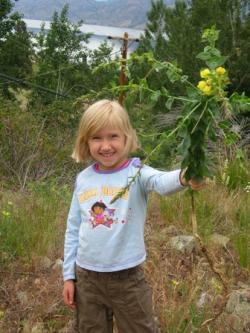
WEEK #26
New Year’s Resolutions
I thought it appropriate to end the year with a list of resolutions that you may wish to consider for 2010, and it has nothing to do with weight loss, more exercise or stopping smoking (not that those aren’t good things to resolve to do). Essentially it is a summation of the advice I have provided over the past seven months, which will help to reduce invasive plants in the Okanagan-Similkameen region and improve the overall health of our natural habitats and agricultural areas. It will also help us save lots of money, because remember, weeds in crops and pastures alone costs Canada approximately $2.2 billion annually.
Whether you've battled bindweed in your back yard, picked hound’s-tongue seeds off your pants or noticed the abundance of Siberian elm trees along our lakes and rivers, you've become aware of the spread of invasive plants. Invasive plants are a problem, but often the solutions are relatively straightforward. Take the time to read through these top twelve resolutions and chose at least one that you can strive to achieve in 2010.
1. Learn to identify invasive plants growing in the Okanagan-Similkameen region. Pick up a copy of the Dirty Dozen booklet or various fact sheets from the regional district at www.rdos.bc.ca.
2. Report sightings of new invaders in our region or patches of common species in remote locations where they may go undetected.
3. When gardening, choose plants wisely. Be suspicious of plants promoted as “fast spreaders” or “vigorous self-seeders.” Do not transplant aggressive species that are known to be invasive. Instead, select native plants that are adapted to our local ecosystems or non-invasive ornamental species.
4. Avoid using exotic wildflower seed mixes.
5. Be wary of wild birdseed mixes. Carefully select the seed mix or create the mix yourself. Put the seed mix on cookie sheets and bake to prevent germination. In the spring, remove any unusual plants growing under or near your bird feeder, before the plant goes to seed.
6. Dispose of invasive plants carefully. Do not ‘recycle’ garden debris or compost. Properly dispose in trash bags or by drying out any material to destroy remaining vegetative parts.
7. Avoid letting invasive plants fruit or set seed, as birds and animals can spread the plants to other areas. Deadhead flowers, seedpods and berries of known invasive plants.
8. Reduce soil disturbances and re-seed disturbed soils with a suitable seed mix.
9. Avoid picking plants from roadsides, gravel pits or other disturbed areas.
10. When exploring the great outdoors, check your vehicle, boat, bike, camping gear, shoes and pets for invasive plant seeds that may have hitched a ride. Dispose of any seeds carefully.
11. Encourage friends and neighbours to learn more about invasive plants, and share information that you have learned such as how to identify a certain species.
12. Get involved with local efforts to control invasive plants.
Well this brings the Weed of the Week series to a close for 2009. Thanks to all the readers who have contacted me with ideas, feedback and lots of questions. I look forward to another series of articles beginning next spring. Happy holidays and best wishes for 2010.
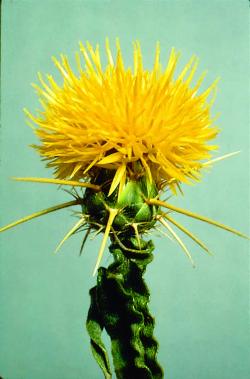
WEEK # 25
Climate Change and Invasive Plants
Much attention has focused on the United Nations Climate Change Conference in Copenhagen this week, so I thought I’d take some time to discuss the connection between climate change and invasive plants. As if the inter-relationships between plants, pest organisms and the environment were not already staggeringly complex, the addition of global climate change bodes yet further complications of the fragile equation. A search of the Internet reveals many models and thoughts from around the world on the implications of climate change on non-native species and the subsequent impact on our natural environment. There is a high level of uncertainty in regional climate projections and even greater uncertainty associated with how natural systems are likely to respond to those changes. But undoubtedly, climate change will result in the proliferation of invasive plants. This is due in part to the ecological flexibility and biology of invasive plants, namely their typically high reproductive rates, fast growth rates, and good dispersal mechanisms. But it is also because the rapid rate of change in climate is likely to be disadvantageous to native plants.
Models and evidence from historical plant migrations - those that occurred at the end of previous ice ages - suggest that although some plant species will likely migrate to areas with appropriate climates, many species will not be able to migrate fast enough to keep pace with current rates of warming. An inability of native species to adapt fast enough to the changing climate regimes will result in a lowered competitive edge and a weakened resistance of ecosystems to infestations by invasive plants. Potential impacts include shifts in the relative abundance and distribution of native species, significant changes in species richness (the number of different species in a given area) and even local extinctions of native species. Subtle changes in the diurnal (day/night) or seasonal patterns of temperature have also been shown to affect plant community composition. Increased average temperature and annual precipitation in BC’s Interior could make it possible for invasive plants now found further south, to migrate north.
Yellow starthistle (Centaurea solstitialis) is probably one of the most likely candidates to move into our region in future years. This member of the knapweed family originated from southern Europe but it was introduced from Chile to California during the gold rush. It has since spread northward into northern Washington State and presently occurs approximately 20 kilometres south of the 49th parallel, with no known occurrences to date in BC. The characteristic knapweed bracts on the starthistle flower head are modified as sharp 2 cm long straw-coloured thorns. Mature plants are 60 to 90 cm (2-3 feet) tall with rigid, branching stem covered with cottony hairs. Bottom leaves are deeply lobed while upper leaves are smooth and sharply pointed. This winter annual may produce up to 170,000 seeds per plant when growing conditions are ideal. Yellow starthistle is toxic to horses, significantly depletes soil moisture in grasslands, lowers yield and forage quality of rangelands, reduces land value, reduces access to recreational areas and decreases native plant and animal diversity. We do not want it in BC.
Experts advise us that climate change is already impacting plants and altering the structure of plant communities. Several plant species are adjusting to local warming by shifting their ranges further northward or toward higher elevations. Many plant species are also responding to climate change by advancing the onset of leaf burst, flowering and fruiting, and delaying leaf drop. In addition, the growing season is lengthening.
Scientists researching crops and climate change, predict similar increases of agricultural weeds. They suggest that warming may favour most weeds in comparison to crops. Rising carbon dioxide is also likely to enhance weed growth relative to crops. Being highly adaptable, many weed species can be expected to rapidly and more effectively adapt to increasing stresses such as rising atmospheric O3 (ozone) and soil salinization (build up of salts in the soil).
Now that I have thoroughly distressed you, it is important to discuss what we can do about it. If you have been following the Weed of the Week series, you will know that weed invasion is exacerbated by soil disturbance and deterioration of the health of natural ecosystems. Invasive species have a history of exploiting habitats left vacant by native species. Reducing unnatural soil disturbances and enhancing the diversity within ecosystems, is an important first step. In some cases, the loss of a natural disturbance has negatively altered a native plant community and we need to take action in order to compensate for this loss. Such is the case in the Okanagan where prescribed burning and thinning are being used to restore our forested habitats. Encouraging conservation and restoration through appropriate land management can also enhance biodiversity. It is also imperative that we learn by doing and continually evaluate what works and what fails to work in an attempt to lessen the impacts of climate change on natural systems.
Without a doubt, invasive plants will continue to present challenges for many years to come. However, if we take action now as a community, we can hopefully reduce opportunities for new invaders such as yellow starthistle to move into our region.
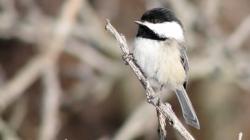
WEEK # 24
kild Bird Seed Can Contribute to Spread of Invasive Plants
As temperatures drop, many landowners are filling bird feeders to provide a helping hand to those species that reside in our region for the duration of the winter. At this time of year, many bird species gather into large flocks, roving widely in search of food. Most of these will congregate readily around bird feeding stations. What does this have to do with invasive plants? Well as it turns out, some of the mixed birdseed packages may be harboring seeds of invasive plants.
Mixed seed is commonly marketed as “wild bird seed”, “wild bird mix”, “finch mix” and so on. There are no regulations about any of these mixes. Seed houses and retailers mix their own and they may not declare the contents on the package. Buying the components separately and mixing them yourself is the only way of being absolutely sure of what you are scooping into your feeders.
Throughout the year, I visit many private properties and help to identify invasive plants and provide management advice. While I cannot always be certain of the original source of invasive plants, some of the more unusual species are commonly discovered either under a bird feeder or in the vicinity of garden plants commonly used by seed feeding birds. This has led me to believe that the source of some invasive plants is indeed birdseed, and the birds then become vectors and assist the spread of these invaders. This conclusion is supported by two studies from the U.S.
In a 2004 survey conducted in Oregon, seeds of more than 50 invasive plant species were identified in 10 wild bird feed brands purchased in that state. All of the brands were found to contain invasive plants, with 10 of the plant species on the state's noxious weed list. These included: buffalobur, bull thistle, Canada thistle, common ragweed, cuscuta species, field bindweed, jointed goatgrass, kochia, puncturevine and velvetleaf. No doubt many of these species sound familiar, as the majority of these invaders are problematic in the Okanagan and Similkameen valleys and have been mentioned in previous articles. When the Oregon researchers tested whether the invasive plant seeds would grow once they fell from a feeder, they found that about 30 plant species beyond the intended ingredients grew within 28 days. Four of those were state noxious weeds.
More recently, a press release issued in 2006 by the Idaho Department of Agriculture indicated that this agency had ordered two dozen companies in the U.S. to stop the sale of bird and other animal feeds that contain noxious weed seeds. Over a period of several months, the department sampled 92 feeds from 34 manufacturers. Lab tests concluded that 54 of the 92 feed samples contained viable noxious weed seeds, including buffalobur, jointed goatgrass, field bindweed, johnsongrass, Canada thistle and hoary cress. Most of the products containing the noxious weed seed were domestic or wild bird feed mixes, but some were also feeds for hamsters, gerbils and squirrels.
Considering the results of these two studies, it is not surprising that “strange plants” are appearing in gardens and other places. So if you do chose to feed the birds during the cooler months, please follow these simple precautions. Carefully select the seed mix, or better yet, create the mix yourself. Consider putting the seed mix on cookie sheets and baking in the oven on the top shelf at 325 degrees for about 15 minutes. The seed still tastes good to the birds, but the heat prevents germination. In the spring, remove any unusual plants growing under or near your bird feeder, before the plant goes to seed. Prevention is the least expensive and often the most practical method for reducing the spread of invasive plants.
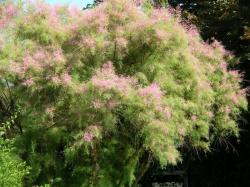
WEEK # 23
SHOWY SHRUBS ARE POTENTIAL INVADERS
While gardening is certainly not on the forefront of everyone’s mind these days, some of you may bide your time during these cooler months by contemplating about what to plant come springtime. Today’s article will focus on three shrubs that are considered to be invasive in certain areas of the Pacific Northwest, and are species I would discourage from planting.
Saltcedar or tamarisk (Tamarix ramosissima) is considered a shrub or small tree, growing from 1.5 - 7.0 metres (5 – 23 feet) tall. Its numerous branches are slender, with small, alternate, greyish-green overlapping or scale-like leaves. Pink or white flowers bloom in dense masses on 1 cm long spikes at branch tips from March to September. The genus Tamarix is native to a zone stretching from southern Europe and North Africa through the Middle East and south Asia to China and Japan. It was introduced to the western United States as an ornamental and for use in erosion control in the mid-1800s. Saltcedar is now established or known in many desert regions of the western US, including Washington, Idaho and Montana. Tamarix ramosissima is sold as an ornamental under the name "Pink Cascade" Tamarisk in some BC nurseries. It is considered an aggressive ornamental that should be prevented from escaping cultivation. Saltcedar reproduces from seed and by re-sprouting from roots and underground stems. A single mature plant can produce thousands of tiny, hairy seeds that are dispersed widely by wind and water. Seeds are capable of germination within 24 hours. Saltcedar most commonly grows on floodplains, along irrigation ditches and on lakeshores, tolerating a wide range of saline or alkaline soils.
Despite its attractiveness, saltcedar poses some serious environmental concerns. Its long taproot penetrates the soil to deep water tables and interferes with natural aquatic systems. Mature saltcedar stems and leaves excrete salt, forming an above and below surface crust which inhibits other plants. These characteristics make it an aggressive colonizer that will replace willows, cottonwoods and other native riparian vegetation. Saltcedar's enormous consumption of water stresses native plants by lowering ground water levels thereby drying up springs and marshes. Its massive rooting system can clog watercourses resulting in flooding. Saltcedar can provide cover for some wildlife species but its foliage and flowers contribute little in the way of food value for native wildlife consumption. It is listed as a legislated noxious weed in six U.S. states. So far, it is not known to have caused a concern in B.C., however landscapers are encouraged to plant alternate vegetation and to ensure existing plantings do not escape.
Butterfly bush (Buddleja davidii) is a large deciduous shrub familiar to most gardeners in the Okanagan-Similkameen region. It grows up to 3 metres (10 feet) tall. Leaves are lance-shaped and have small serrations along the edges. While the tops of the leaves are dark green in color, the undersides are given a light appearance from numerous whitish hairs. The small, fragrant, funnel-shaped flowers are usually purple, although there are also red, pink, blue, orange, yellow and white varieties. The flowers are borne in showy spikes at the ends of the stems and bloom from mid-summer into the fall. Winged seeds - up to three million per plant (!) - are easily dispersed via wind or water.
Buddleja is native to the temperate regions of China. Although cultivated as a garden ornamental, it is able to colonize disturbed and natural areas including roadsides, riverbanks and gravel bars. It is capable of growing in low-nutrient substrate, such as the gravelly substrate of streambeds. One further consideration is that while butterfly bush acts as a nectar source for many insects, it does not provide a food source for the larval stages of native butterflies. In fact, some U.S. researchers suggest that it may be displacing native nectar sources in Washington and Oregon. This shrub has been placed on the noxious weed list in these two states.
Although not as common as the first two species, sea buckthorn (Hippophae rhamnoides) is another shrub that occurs in our region, and has shown invasive properties in other areas of Canada as well as the U.S. Sea buckthorn is a deciduous winter-hardy shrub that reaches 2 to 5 metres (6.5 – 16.4 feet) in height. The silver-grey leaves of sea buckthorn are alternate and narrow. The small, yellow flowers appear in spring before leaves. Small, yellow to orange berries remain on the shrub throughout the winter.
In 2005, sea buckthorn was as ranked as the fifteenth most invasive plant of natural habitats in Canada following presentations at the 2004 Canadian Botanical Association's second symposium on invasive alien plants in Canada. This plant has recently attracted interest worldwide for its economic value as a nutritious food, a medicine, a soil enhancer, a pollution reducer, a source of firewood, and as a landscape management tool. It has been widely planted on the Canadian prairies to improve soil through nitrogen-fixing capability, to prevent erosion in dry and especially saline areas and for use as a shelterbelt. More recently it has attracted attention in Canada as an alternative crop, the leaves and berries being processed into a range of health foods and herbal products. Oil from the plant is also used for medicinal and cosmetic purposes.
Despite its many virtues, sea buckthorn can be a serious problem. It was apparently first listed as an invasive in Canada in 1997. In Alberta, it has established extensive monocultural stands on gravel and sandbars along streams. The potential risk to BC’s natural ecosystems has been brought to the attention of the provincial government.
So, what to do if you have these shrubs? I am certainly not suggesting that if you have these shrubs on your property that you should immediately remove them. Instead, I encourage you to take measures to confine them within the bounds of your garden and remove volunteer seedlings. I also hope that this article encourages landowners to carefully consider what species to plant in their garden, based on a review of plant characteristics in relation to the location of your property. While not yet a problem in our region, these three species are examples of plants that have escaped cultivation and demonstrated detrimental impacts in natural areas that they invade, particularly riparian habitats (stream banks or lakeshores). So take extra caution if your property supports natural areas such as a creek or wetland, or if you live adjacent to such a habitat.
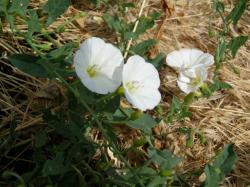
WEEK #22
Invasive Vines: Part Two
Last week I introduced you to invasive vines. In today’s article, I will introduce you to a few more creepy crawlies of the botanical world.
One of our region’s highest priority species just so happens to be a vine. Puncturevine is an invasive plant that has already impacted our region’s tourism industry by invading the beaches and bicycling trails in Oliver, Osoyoos and Penticton, and more recently it’s having an economic impact on our agricultural industry as it moves into ground crops and vineyards. It forms dense mats along road shoulders, vacant lots, beaches and unpaved parking sites, its stems reaching up to 3 metres (10 feet) in length. Puncturevine is one of those weeds that you want to take all efforts to ensure it does not move onto your property. If you are doing any landscaping, check your sources of fill and gravel, as this seems to be one of the most common means of introduction into a new area. I have mentioned this weed in a previous article, so I won’t delve into further details here.
One of the most unique invaders in our region is a vine called parasitic dodder (Cuscuta spp), also known as strangleweed. As its name implies, this plant is a parasitic annual forb. There are five species of dodder in BC, and two of them are native species; the other three were introduced from Eurasia. The most distinguishing feature about this invasive plant is its slender, thread-like stems, which are bright orange and coil around its host plant, adhering with wart-like suckers. Dodder attacks many vegetables, forage crops (particularly alfalfa) and ornamentals. They can also parasitize many native plants from herbs to shrubs, although I have noticed a particularly close host relation with plants of the goosefoot family, particularly Russian thistle. The lifecycle of dodder is most intriguing. The seeds germinate in the soil and produce slender stems, which have a short time to make contact with a host plant before the seedling dies. The dodder twines around the host plant and develops suckers that penetrate the host, extracting food from it. The dodder then loses contact with the soil. Stems of the dodder proliferate, sometimes forming dense mats, and then tiny creamy white flowers and seed are produced. Small infestations can be hand pulled and bagged, while in agricultural settings, patches can be cut and burned. Unfortunately tillage alone is not an effective control tool. If you discover dodder on your property, thoroughly clean equipment, tools and footwear before leaving the infested area. Hay infested with dodder should not be bought or sold. Agricultural producers, home gardeners and nursery growers should be on the lookout for this devastating parasitic plant and take immediate action if the weed is found or suspected.
The Morning Glory Family (Convolvulaceae) includes many different invasive vines that are widely cultivated for their colourful funnel-shaped flowers. Because of their fast growth, twining habit, attractive flowers and tolerance for poor, dry soils, some morning glories are excellent vines for creating summer shade on building walls when trellised. However, in some situations, morning glories develop thick roots and tend to grow in dense thickets. They can quickly spread by way of long creeping stems. By crowding out, blanketing and smothering other plants, some species of morning glory have turned into a serious invasive weed problem. A more commonly occurring and equally invasive morning glory is field bindweed (Convolvulus arvensis). Field bindweed, also known as creeping Jenny, is a white-flowered perennial with long, trailing, somewhat twining stems. This persistent perennial vine forms dense, tangled mats on the ground or climbs up shrubs and trees. Stems can grow in excess of 1.5 metres (5 feet) long, while roots can be over 6 metres (20 feet) long. Mature leaves are arrowhead-shaped and 2-6 cm long. Trumpet-shaped, white to pinkish-purple flowers bloom in summer, closing each afternoon and reopening the following day. Bindweed seeds remain viable in the soil for 20 years or more. Young plants generally begin producing seed in their second growing season. Seeds germinate throughout the growing season, but peak germination usually occurs mid-spring through early summer. Fragments of vertical roots and rhizomes can also form new plants. Shoots form from lateral roots, enabling a plant to spread more than 3 m in a growing season.
Control of field bindweed in an area cannot be accomplished with a single treatment or in a single season. This plant is very drought tolerant and once established is nearly impossible to eradicate. It is important to address new infestations when they are small, because spot control is the most effective and least expensive control technique. Hand weeding is only temporarily effective and is not recommended because field bindweed sprouts from root fragments left behind. In cultivated areas, deep plowing to turn the soil and expose the bindweed roots to the sun may be effective.
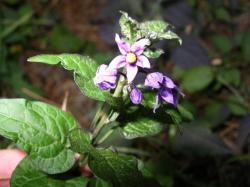
WEEK #21
Invasive Vines: Part One
Vines are commonly found on many properties in the Okanagan-Similkameen. By definition, vines are plants that gain altitude by climbing on the backs of others, rather than by standing up on their own. They are, in botanical terms, "mechanical parasites," mooching from others the woody backbones that they lack. Whether they are climbing the side of a building or bordering a pathway, they often add an attractive dimension to your landscaping. Vines can also provide shade by growing on an arbor or trellis or provide us with wine or other consumables from their fruit. Vines can have many redeeming qualities, but beware of the invasiveness of many species. They can creep and crawl and eventually block out sun from other plants or even choke them as a parasite. So before you plant a new vine, find out whether or not it will take over your garden or move beyond your property to invade an adjacent creek or green space. Here are a few invasive vines that grow in our region.
Himalayan Blackberry (Rubus armeniacus) is a thicket-forming thorny plant of the Rose family. It is a vine you can love and hate at the same time. Contrary to its name, it is actually native to Armenia. This blackberry species was intentionally introduced into Vancouver around 1885. In British Columbia, it is a semi-evergreen perennial that grows in alleyways, along railroad tracks, invades clear-cuts, roadsides and riparian areas, with unlimited spread. Himalayan blackberry leaves come in sets of three or five and are large, round and toothed. The strong stems have stiff thorns or prickles. The plant first appears as individual canes, which can reach up to 3 metres (10 feet) in height. Trailing canes can grow as much as 7 metres (23 feet) in one growing season. The canes form great mounds or banks, resembling a shrub. Second year canes, which grow off the first years, bear the white flowers and black fruit. The fruit ripens from mid-summer through fall. Canes can root when the tips touch the ground, forming a dense network of prickly thickets. Blackberries also propagate via root pieces and cuttings and can branch daughter plants from mature canes. Shoots can arise from underground runners that persist up to a meter deep and over 10 meters long. Blackberry thickets can yield up to 13,000 seeds per square meter; birds and other animals then spread these seeds. Blackberry plants can deteriorate valuable riparian habitat by preventing the establishment of deep-rooted native shrubs, which are a critical for healthy creeks and rivers, providing food, shade, and bank stability. However, blackberry shrubs do offer limited food, nesting sites and wildlife cover (and make great blackberry pies!) Himalayan blackberry is extremely difficult to remove as plants grow very fast and have efficient reproductive success. Nevertheless, stands can be controlled through vigorous cutting, replacement planting, and monitoring efforts. Control must include removal of the above ground vegetation, and the destruction of the root crowns and major lateral roots. While not yet a common invader of our region, blackberry does pose concern in some localized areas and it has the potential to spread to many uninfested areas. In any areas being managed for their wildlife values, I strongly encourage its removal.
Another invasive vine common to our area is climbing nightshade (Solanum dulcamara), also known as European bittersweet, bittersweet nightshade, woody nightshade, scarlet berry, fellenwort, poison bittersweet and dulcamara. This vine is probably the most widespread poisonous weed in our region, yet few people are familiar with this perennial invader. It is native to temperate Eurasia and northern Africa, but is now generally considered to be naturalized across most of Canada and the United States. Climbing nightshade has been widely planted for ornamental and medicinal purposes, which has contributed to its widespread occurrence across North America. As its name suggests, this nightshade species has long branches that trail or climb on other plants. This sprawling vine is frequently seen in riparian woodlands next to creeks and lakes, often draping over trees and shrubs. While it most commonly grows in wet sites or sites close to water in the valley bottom, it will also grow in moist upland sites such as ditches, orchards and open forests.
The base of climbing nightshade is woody, and the upper herbaceous branches die back to the woody portion each year. Its lance shaped leaves are lobed at the base. Climbing nightshade has very distinctive bluish-purple flowers with yellow anthers, which hang in clusters and are visible throughout the summer. Hanging clusters of bright red, egg-shaped berries ripen throughout the summer and fall. Although all parts of the plant are considered toxic, the berries have the greatest toxicity and unripe berries are more toxic than ripe berries. Symptoms of poisoning include nausea, vomiting, salivation, drowsiness, abdominal pain, diarrhea, weakness or respiratory depression.
Small infestations of climbing nightshade can be manually pulled, dug out or cut back. The plants will re-sprout from roots and root fragments but repeated pulling can eventually give good control. Pieces of the cut vines may re-sprout if left lying on the soil, so take care to remove all or as much of the plant fragments as possible from the site. Mowing may work as a control, but would likely have to be repeated several times during each growing season.
Next week’s article will be a continued discussion of the many invasive vines that occur in our region.
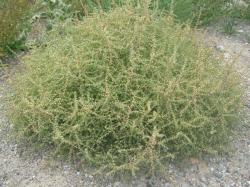
Week # 20
Tumbling Weeds
This article was written by my assistant, Jessica Hobden.
After a blustery walk along a newly paved subdivision road, I became aware that I was dodging fast-moving plants. Side stepping and jumping, I realized these rolling plant skeletons were what I had been dealing with all summer. However, the invasive plants I had come to know were no longer in the ground…there were pieces in my hair, on my pants, stuck to the dog and guiltlessly attached to the underside of my car. With the passing of fall, plants are dying, but many are still managing to spread their seeds. They are what people know as tumbleweeds.
Tumbleweeds are found in most dry areas of the South-Okanagan Similkameen and are very abundant where the land has been disturbed: empty lots, construction sites, roadsides and along trails and other corridors. Invasive plants thrive in these disturbed locations and all have their own way of propagating and spreading seed. Some are hitch-hikers, like hound’s-tongue, and cling to passing objects. Some are explosive and shoot their seeds several metres, like leafy spurge. Other species take advantage of wind or water. Dandelions and thistles have the idea of the parachute engineered into their genes and others, like diffuse knapweed, Russian thistle and mustard roll around the landscape, propelled by wind.
Diffuse knapweed (Centaurea diffusa) is one of thirteen knapweed species in BC. This biennial or short-lived perennial is grayish green and its many branches grow from a single upright stem. The flowers are typically white and some are purple, but with the arrival of fall, their blooms have perished. Each flower head is composed of a bulb below the petals that has short, spiny bracts. Diffuse knapweed is unique from our other Okanagan knapweed species in that it breaks off at the base when it reaches maturity and dries out, then it tumbles around in the wind. This technique makes it very effective in spreading thousands of seeds great distances. One plant can produce up to 18,000 seeds and they can remain dormant in the soil for up to 80 years. Because of these amazing characteristics, knapweed has triumphed in the weed world. It has become very prolific in North America since its introduction around 1907, likely via contaminated crop seed from Eurasia.
The most effective management method for diffuse knapweed is to prevent establishment. Small infestations should be dealt with immediately by hand pulling plants. Cutting or mowing before seed-set can be effective to reduce seed production, but it will not eliminate large infestations. Fortunately, biological control - the use of natural enemies to control weed infestations - is proving extremely favorable for large patches of diffuse knapweed. In recent years, notable reductions in diffuse knapweed infestations have been observed, namely due to damage caused by the Larinus beetle. During its adult stage, this tiny beetle feeds on young leaves and stems during the spring, while single larvae can consume the entire contents of the flower head in which they were laid. Other effective bioagents attack the root of knapweed, resulting in weakened and stunted plants.
Another common tumbleweed on our region is Russian thistle (Salsola kali). Originally from Eurasia, the plant was first recorded in 1877 in South Dakota and has since made its way to the Pacific coast. This spiny annual is a monster to handle once it matures. As a young plant it is a grass-like succulent, bright green with vertical red or purple striations and is relatively easy to remove. However, as it matures, it grows into a dense, bush-like mass, eventually drying out into a brown brittle skeleton. The plant can range from the size of a soccer ball to something you could not fit through your front door. Its flowers are reddish-pink and surrounded by its sharp spiny leaves. One plant can produce up to 250,000 seeds. The seeds are black and shiny, and readily fall to the ground as the plant tumbles around. Russian thistle can only be managed by eliminating seed production and by depleting the soil seed bank. Mowing or pulling young plants can be effective. Disturbed areas should be seeded to perennial grasses to provide competition and eliminate a niche where this weed may establish.
The other common tumbleweed in the Okanagan-Similkameen is tumble mustard (Sisymbrium altissimum). It is a multi-stemmed annual herb from Europe. The stems are upright and branched, creating a tall bush-like appearance. Coarse, saw-toothed leaves grow on the lower half of the plant, while the upper leaves are reduced, fine and lobed. This mustard can reach heights of up to 1.5 metres (5 feet), although plants are typically less than one metre tall (3.2 feet). The four-petalled flowers are yellow and the fruit or capsules are long and slender and house many tiny seeds in single file. Once it breaks off, the plant is a maze of tangled branches and hollow space, ideal for catching the wind and scattering its tiny seeds.
Fortunately, tumble mustard is not a strong competitor and can be controlled relatively easily. New plants can be pulled or dug out in early spring, while mowing will prevent mustard from flowering and setting seed. In agricultural settings, it is important to reduce tillage and disturb the soil minimally, or a competitive planting should follow tillage. Maintain a healthy pasture by fertilizing and watering to encourage grasses to grow and shade out mustard and other invasive plants.
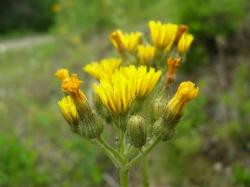
Week #19
The World’s Scariest Invasive Plants
Being as though Halloween is only a few days away, I thought I would talk about some of the world’s scariest invasive plants. These are the species that we should thank our lucky stars that they do not occur here…at least not yet. They are some of the fastest growing, most ecologically destructive plants in the world.
Kudzu is a climbing, deciduous vine capable of reaching lengths of over 30.5 m (100 ft). Preferred habitat includes open, disturbed areas such as roadsides, right-of-ways, forest edges and old fields. Kudzu often grows over, smothers and kills all other vegetation, including trees. Kudzu is native to Asia and was first introduced into the United States in 1876 at the Philadelphia Centennial Exposition. It was widely planted throughout the eastern United States in an attempt to control erosion.
Now it covers between 20,000 and 30,000 square kilometres of land in the southeast US and costs the economy half a billion dollars a year in lost farmland and efforts to control it. Common names for kudzu include: mile-a-minute vine, foot-a-night vine, and the vine that ate the South.
Water hyacinth is native to South America, but is now widespread in Asia, Africa, North America, Australia and the UK. It was introduced to North America in the late 1800s as an ornamental pond plant. It is a free-floating perennial plant that can grow to a height of one metre (3 feet). Underneath the water is a thick, heavily branched, dark fibrous root system, while above the water, this invader has striking light blue to violet flowers located on a terminal spike. Water hyacinth is one of the fastest growing plant species in existence. Populations can double their size in as little as two weeks. If not controlled, it can cover literally an entire lake or pond. This blocks sunlight, impacts water flow and starves the water of oxygen resulting in fish kills and impacts to other aquatic species.
Another plant that deserves special mention is Salvinia molesta, an aquatic fern. Originally from South America, it is now scattered throughout the southeast US, and is also know to occur in Southern California and Hawaii. This plant spreads at an alarming rate; it is able to double its numbers every 2.2 days under ideal conditions. If you consider this doubling rate and add just one plant to a water body, you will have over 8,000 plants within the first month. Equally troublesome is the fact that this fern reproduces as portions break off. This means that if a boat travels through a mat of these weeds there is a good chance that the plant will break into several pieces which each have the ability to grow into new plants. Also, the plant grows in large, thick mats. Mats of salvinia have been recorded to be as large as 96 square miles in area and up to 3 feet deep. These mats can block all sunlight from entering the water and as they decay, the plants can cause a decrease in dissolved oxygen in the water body. Both of these actions will severely reduce the habitat available for fish. Sadly this plant was most likely introduced through the aquarium and landscaping trades, and this continues to be a possible route of infestation. This plant has been sold under many common names including water velvet, salvinia, giant salvinia, African pyle, aquarium watermoss, kariba weed, water fern and koi kandy.
While the plants I have mentioned have not yet migrated to BC, there are already many villainous and eerie species that occur here that pose rather formidable economic impacts in our province. If I haven’t spooked you enough already, I will leave you with these parting thoughts, which recently came to light as part of a study on the economic impacts of invasive plants in BC.
The study focused on seven invasive species present in BC. These species are: purple loosestrife (Lythrum salicaria), diffuse knapweed (Centaurea diffusa), hawkweed (Hieracium sp.), cheatgrass (Bromus tectorum), scotch broom (Cystius scoparious), Eurasian watermilfoil (Miriophyllum spicatum) and Dalmatian toadflax (Linaria dalmatica). Without intervention, the economic damage caused by each one of the selected invasive species was estimated to range from $1 to 20 million dollars in 2008, increasing to between $5 and 60 million by 2020 (based on 2006 Canadian dollars). The total expected damages, in the absence of any management, were estimated to be a minimum of $65 million in 2008, rising to $139 million by 2020. These values are likely underestimates as economic data were not available for all potential impacts. Have I scared you yet?
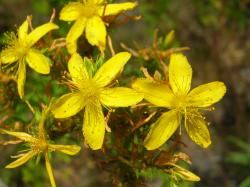
Week #18
Medicinal Weeds
With so much emphasis on the H1N1 flu virus these days, it seemed timely to make the connection between weeds and human health. While some invaders are known for their toxic properties, this article will instead focus on more redeeming qualities. To the average person, the term 'weed' connotes a good-for-nothing, unproductive plant, which competes with crops or garden plants for water and nutrients. Weeds generally have negative connotations because they are growing in areas where people do not want them to be and because they grow relatively fast and invade where other plants are trying to grow. However, many plants classified as weeds have medicinal value and in some cases these qualities are the root cause for the plant’s existence in Canada. Even the ubiquitous dandelion has been used for centuries to treat liver, gall bladder, kidney and joint problems. In some countries, dandelion is considered a blood purifier and is used for ailments such as eczema and cancer. Dandelion has also been used to treat poor digestion, water retention, and diseases of the liver such as hepatitis. While it technically is a weed, dandelion does not rank high on my list of priority weeds. There are some highly aggressive species that pose a threat to our natural environments, yet posses astonishing medicinal benefits.
The weed that surprises most people in the Okanagan-Similkameen region is St. John’s-wort (Hypericum perforatum). This particular perennial is widely known for its anti-depressant properties. However, its dominance as an invasive plant in grasslands and open coniferous forests is not so widely recognized. St. John's-wort has been used for centuries to treat mental disorders and nerve pain. In ancient times, herbalists wrote about its use as a sedative and a treatment for malaria, as well as a balm for wounds, burns and insect bites. Today, St. John's-wort is used for depression, anxiety and sleep disorders. These same chemical constituents depress the central nervous system of grazing animals and increase their sensitivity to temperature change and handling. St. John’s-wort also affects the liver of grazers, causing temporary sensitivity to sunlight. Fortunately, livestock usually avoid it unless food is scarce. For those landowners who are batting a severe invasion of St. John’s-wort on their property, there is good news. Foliage feeding Chrysolina beetles have proven very effective at controlling this weed, and are considered the first success story of B.C.’s biological control program dating back to the 1950s.
Burdock (Arctium species), which I have discussed in previous articles, is a tenacious weed in our region that has leaves resembling those of rhubarb in size and shape. Flower heads are round and thistle-like, with numerous, small purple-hued, funnel-shaped blooms in mid-summer to early fall. Blossoms are surrounded by stiff, prickly, hook-tipped burrs that grasp and hold firmly to clothing and fur. Medicinally, this weed aids skin disorders, such as boils, acne, eczema and psoriasis. It also acts as a tonic to the digestive system and is a wound healer.
Herbalists also value several thistle species. The roots of bull thistle (Cirsium vulgare) - a biennial with deeply cut and prickly leaves with long yellow spines - have been used as a poultice and a decoction of the plant used as a poultice on sore jaws. A hot infusion of the whole plant has been used as an herbal steam for treating rheumatic joints. The root of Canada thistle (C. arvense) – a perennial with dark green, wavy leaves - has been chewed as a remedy for toothache, while a decoction of the roots has been used to treat worms in children. A leaf tea made from Canada thistle is used as a tonic and diuretic and has been used for tuberculosis. Externally, this thistle species has been used for skin eruptions, skin ulcers and poison-ivy rash.
And lastly, who would have ever guessed that puncturevine (Tribulus terrestris) – the summer annual with spiny seedpods strong enough to puncture a bicycle tire – has a huge list of medicinal qualities. Considered an important diuretic herb in Ayurvedic (India) and Chinese medicine, it is recommended for urinary problems, kidney and lower back pains and as an aphrodisiac. It also increases testosterone levels and is consequently used by bodybuilders as a natural alternative to chemical anabolic steroids.
So next time you are frantically pulling weeds on your property, remember that just as beauty lies in the eye of the beholder, depending on how one looks at it, the same plant can be labeled a weed or a valuable herb!
(Hypericum perforatum). This particular perennial is widely known for its anti-depressant properties. However, its dominance as an invasive plant in grasslands and open coniferous forests is not so widely recognized. St. John's-wort has been used for centuries to treat mental disorders and nerve pain. In ancient times, herbalists wrote about its use as a sedative and a treatment for malaria, as well as a balm for wounds, burns and insect bites. Today, St. John's-wort is used for depression, anxiety and sleep disorders. These same chemical constituents depress the central nervous system of grazing animals and increase their sensitivity to temperature change and handling. St. John’s-wort also affects the liver of grazers, causing temporary sensitivity to sunlight. Fortunately, livestock usually avoid it unless food is scarce. For those landowners who are batting a severe invasion of St. John’s-wort on their property, there is good news. Foliage feeding Chrysolina beetles have proven very effective at controlling this weed, and are considered the first success story of B.C.’s biological control program dating back to the 1950s.
Burdock (Arctium species), which I have discussed in previous articles, is a tenacious weed in our region that has leaves resembling those of rhubarb in size and shape. Flower heads are round and thistle-like, with numerous, small purple-hued, funnel-shaped blooms in mid-summer to early fall. Blossoms are surrounded by stiff, prickly, hook-tipped burrs that grasp and hold firmly to clothing and fur. Medicinally, this weed aids skin disorders, such as boils, acne, eczema and psoriasis. It also acts as a tonic to the digestive system and is a wound healer.
Herbalists also value several thistle species. The roots of bull thistle (Cirsium vulgare) - a biennial with deeply cut and prickly leaves with long yellow spines - have been used as a poultice and a decoction of the plant used as a poultice on sore jaws. A hot infusion of the whole plant has been used as an herbal steam for treating rheumatic joints. The root of Canada thistle (C. arvense) – a perennial with dark green, wavy leaves - has been chewed as a remedy for toothache, while a decoction of the roots has been used to treat worms in children. A leaf tea made from Canada thistle is used as a tonic and diuretic and has been used for tuberculosis. Externally, this thistle species has been used for skin eruptions, skin ulcers and poison-ivy rash.
And lastly, who would have ever guessed that puncturevine (Tribulus terrestris) – the summer annual with spiny seedpods strong enough to puncture a bicycle tire – has a huge list of medicinal qualities. Considered an important diuretic herb in Ayurvedic (India) and Chinese medicine, it is recommended for urinary problems, kidney and lower back pains and as an aphrodisiac. It also increases testosterone levels and is consequently used by bodybuilders as a natural alternative to chemical anabolic steroids.
So next time you are frantically pulling weeds on your property, remember that just as beauty lies in the eye of the beholder, depending on how one looks at it, the same plant can be labeled a weed or a valuable herb!
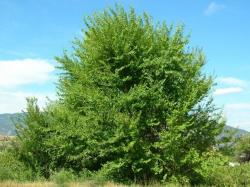
Week #17
INVASIVE TREES
A few weeks ago, I was pleased to see Scott Austin’s Turf’s Up article focus on tree-of-heaven (Ailanthus altissima), one of several invasive tree species that is unfortunately all too common in our region. As a reminder, tree-of-heaven resembles the sumacs and hickories, but can be distinguished by the glandular, notched base on each leaflet. These trees can reach an impressive 24 metres (80 feet) in height and 1.8 metres (6 feet) in diameter. Native to central China, tree-of-heaven was introduced to the east coast of North America in the late 1700s and became common stock in eastern nurseries by 1840. In the late 1800s, it arrived on the west coast, brought to California by Chinese miners during the gold rush. Escaping from cultivation and quickly becoming established on both coasts, tree-of-heaven has expanded its range considerably since its initial introductions. This invasive tree is a prolific seed producer and can successfully compete with native vegetation. It reportedly produces toxins that prevent the establishment of other species, and the root system is aggressive enough to cause damage to sewers and foundations.
As already noted, tree-of-heaven is not the only invasive tree species in the Okanagan and Similkameen valleys. Another even more common species is Siberian elm (Ulmus pumila), which was introduced to North America in the mid-1800s for its hardiness, fast growth and ability to grow in various moisture conditions. Its native range includes Northern China, eastern Siberia, Manchuria and Korea. Siberian elm grows readily in disturbed areas with poor soils and low moisture. It reaches heights of 9-18 metres (30 – 60 feet) with an open rounded crown and slender, spreading branches. Its bark is dark gray and shallowly furrowed on a mature tree. Leaves are small, elliptic and toothed, with a short point at the tip. The fruit is winged, round and smooth, and hangs in clusters. The abundant, wind-dispersed seeds allow this tree to spread rapidly, forming dense thickets that displace native vegetation and reduce forage for wildlife and livestock. It is very prolific along channelized sections of the Okanagan River, particularly north of Oliver and between the communities of Oliver and Osoyoos.
Another aggressive tree species in our region is black locust (Robinia pseudoacacia). This species reaches heights of 9 to 24 metres (30 to 80 feet) and has a shallow, fibrous root system. Young saplings have smooth, green bark, while older trees have deep, furrowed, shaggy, dark bark with flat-topped ridges. Leaves are alternate and pinnately compound with 7 to 21 leaflets. Leaflets are thin, elliptical, dark green above, and pale beneath. Most distinctive are the heavy, paired thorns that grow on smaller branches, as well as the shiny, smooth and flat seedpods that are 5 to 13 cm (2 to 4 inches) long. Black locust has been planted extensively for its nitrogen fixing abilities, as a source of nectar for honeybees, and for fence posts and hardwood lumber. Its commercial value and soil building properties encourages further transportation outside its natural range. It is native to the Southern Appalachians and the Southeastern United States. The tree has been planted in many temperate climates and is naturalized throughout the United States, within and outside of its historical range, and in some parts of Europe. Once introduced to an area, black locust expands readily into areas where their shade reduces competition from other sun-loving plants.
And I would be remiss if I did not mention Russian olive (Elaeagnus angustifolia), which is also known as oleaster or silverberry. It can grow up to 9 metres (30 feet) in height and is often thorny. The upper surface of its lance-shaped leaves are light green in color and are covered with silvery star-shaped hairs, and the lower surface of its leaves are silvery white and densely covered with scales. Russian olive produces an abundance of yellow-red, olive-shaped fruits that are readily eaten by many species of birds, which works to disperse the seeds. It is native to Europe and western Asia and was originally planted in the United States beginning in the late 1800s, most commonly as a windbreak tree that is extremely tolerant of environmental factors. By the mid-1900s it had escaped cultivation into the central and western U.S., and is now extensively naturalized in 17 western states. It also occurs in southern Canada, from British Columbia to Ontario. In the Pacific Northwest, it has become a major problem in riparian woodlands, threatening even large, hardy native trees such as cottonwoods. Russian olive can form dense stands that alter vegetation structure, nutrient cycling and the hydrology of a system. While it occurs in a variety of soil and moisture conditions (such as on bare mineral substrates or in nitrogen-poor areas), Russian olive prefers sandy floodplains and is often associated with open, moist riparian habitats.
To effectively control these aggressive trees, seedlings can be hand-pulled when the soil is moist. Once they become firmly established, the most effective control method is the cut-stump herbicide treatment during late spring. This method is both labor intensive and expensive, but can be highly effective. Bulldozing, mowing and brush cutting can also be effective, but only if all re-sprouts are continually cut and removed which will likely take many consecutive years of treatment. Girdling may also be an inexpensive and useful technique for controlling these undesirable trees. Girdling involves manually cutting away bark and cambial tissues around the trunks of trees. This control method should be undertaken using an ordinary axe in the spring when the trees are actively growing. Note that hardwoods are known to re-sprout below the girdle unless the cut is treated with herbicides. I strongly encourage anyone dealing with invasive trees to consult with a professional before attempting these control techniques.
For anyone who wishes to view Weed of the Week articles on the Internet, note the Direct Link to the Invasive Plant Program on the home page of the RDOS website www.rdos.bc.ca. For more information on invasive plants, contact Lisa Scott, Invasive Plant Program Coordinator for the Okanagan-Similkameen Regional District at (250) 492-0237 or email info@rdos.bc.ca
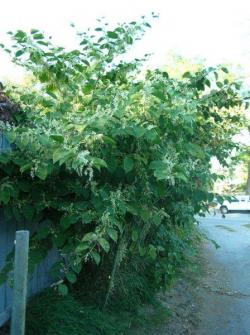
Week # 16
COMPOSTING WEEDS SHOULD BE AVOIDED
As I walked around Summerland’s Farmers’ Market this week, I was amazed at the amount of locally grown produce that is still readily available. It has been an incredible growing season and this weekend I think we should all give thanks for the fantastic fall weather. However, as with all good things, they do come to an end and many of you likely have plans to put your gardens to bed this weekend or otherwise do some yard work in preparation for the cooler months ahead.
While fall may not seem an ideal time to take action to control invasive plants, in fact landowners should be taking action now in an effort to reduce next year’s weed problems. Most weeds have now reached maturity and produced seed, so proper disposal is extremely important. Some examples of seed bearing invaders that need some attention right now are hound’s-tongue and burdock. These are the hitchhiker weeds that I have spoken about in previous articles. Hound’s-tongue is a tap-rooted biennial that produces teardrop shaped seeds that are covered with hooked prickles. Seeds readily attach to clothing and animals. Burdock has rhubarb-like leaves and large, distinct seed heads that have many thin, hooked spines or bracts, which become a large sticky mass. You should clip the seed stalks of both of these invasive plants right now, but removal of the root is unnecessary. We’ve also had a bumper crop of puncturevine this year, so this is another invasive that deserves some attention at this time year if you were unable to hand pull during the summer months. These invaders and any other mature plants with seeds that are removed by physical means should not be composted but instead should be carefully bagged or loaded into the back of a truck (covered with a tarp or canopy), and disposed of at the landfill. Be sure to inform the landfill operator that you have invasive plants and not simply yard waste, to ensure that your weeds are disposed of in the proper location. And if you have curbside pick up, do not include any invasive plants with your yard waste.
The majority of composting practices and processes often do not reach and maintain the temperatures needed to assure the destruction of all viable seeds; this is particularly the case with backyard composts. A study by Agriculture Canada indicated that some species of weeds, including wild mustard and stork’s-bill, were killed early in the composting process, with the temperature held at just 39 degrees Celsius for a week – a fairly low temperature for compost piles, which should be generating temperatures of 55-60 degrees Celsius. However, a graduate student in Washington recently showed that temperatures in excess of 100 degrees Celsius were required to effectively destroy the seeds of Dalmatian toadflax. While these extreme temperatures are not required for destruction of most seeds, it is clear that weed seeds are highly variable in their ability to withstand the high temperatures inherent in the composting process. Also, species such as knotweed, morning glory (bindweed), sheep sorrel, ivy, several kinds of grasses, and many other plants can re-sprout from their roots or stems in the compost pile. Do not compost these weeds unless they are completely dead and dry. Keep this in mind as you dispose of the annual plants in your planters and hanging baskets. Improper disposal of garden waste can result in undesirable ornamental plants moving into natural areas or parks adjacent to your property.
Not all weeds overwinter as seed. Those that do are hard to control at this time of year. They are best controlled by diligent removal throughout the growing season. Perennial weeds can be removed by hand at this time of year and even if you do not get the entire root, it may winter kill. The best weeds to control at this time of year are those classified as winter annuals. Winter annuals are a specialized group of plants that germinate in the fall or winter and grow during any brief spell of warm weather, but otherwise remain somewhat dormant during the winter. They over-winter as low rosettes, resuming growth and producing seed in the spring. These plants typically finish their life cycle in late spring and early summer, as temperatures increase. Winter annuals are prolific seed producers and their spread is mainly by seed. These rather inconspicuous plants typically go unnoticed during the cooler months, becoming much more visible in their flowering and reproductive stages of growth.
The key to successful weed management is persistence. So taking the time to weed early and often typically reduces the time and expense that must be devoted to addressing seed bearing plant materials.
Also, keep in mind that fall is an excellent time to seed disturbed soils, particularly if your location is non-irrigated. During this time of year, seeding projects can take advantage of the fall rains. The soil is basically storing the dormant seeds until spring, at which time the soil will warm up signaling the seed to germinate. This process will also allow the seedlings to take advantage of the moisture from winter snow.
And don’t forget that the deadline for the photo contest is looming. You have until October 15 to submit a photo of an invasive plant for a chance to win some great prizes. It could be of a field of weeds, a single plant, a close up of a leaf, prickle or flower stalk....get creative!
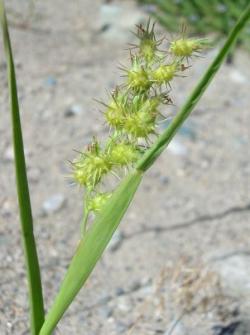
Week #15
INVASIVE GRASSES OF THE OKANAGAN
Two of the Okanagan’s most prolific invasive plants that catch the attention of Okanagan residents and tourists in the summer and early fall are grasses. I am speaking of cheatgrass and longspine sandbur. Both of these species have seeds that like to ‘hitch a ride’ on an unwary traveler. These introduced grasses invade roadsides, eroded areas, abandoned fields, burned areas and heavily grazed grasslands. They form dense stands on sites that have been previously disturbed, creating monocultures and out-competing desirable vegetation.
Cheatgrass or downy brome (Bromus tectorum) is likely familiar to most residents of the Okanagan-Similkameen. This annual weed was one of our earliest Eurasian invaders, arriving to the Columbia Basin in contaminated seed in the 1890s then spreading via the railways across the west. Without a doubt, it is the most prolific invasive plant in our region and it exhibits amazing ecological amplitude. It grows on all exposures and all types of topography from desert valley bottoms to local mountain peaks. It has earned the nickname ‘speargrass’ due to its sharply pointed seeds. The seeds commonly penetrate socks and boot laces during the summer months or lodge themselves in the paws or ears of unwary dogs. Mature cheatgrass can be as short as 2.5 cm (1 inch) or as tall as 60 cm (2 ft). Cheatgrass changes colour from green to purplish-red to brown as the plant matures and eventually dries. Branches are slender, drooping and hairy, hence the alternate name downy brome. Because cheatgrass grows throughout fall and winter, by the time the rain stops in spring, cheatgrass seeds are already maturing. Unlike native bunchgrasses, cheatgrass then dies by the end of July, avoiding the hottest and driest part of summer. This gives it an advantage over native grasses. When dry, cheatgrass is extremely combustible and can represent a major fire hazard.
Longspine sandbur (Cenchrus longispinus), also known as burgrass, is a more recent invader of our region. So far, plants are limited to the southern portion of the Okanagan valley and have not been observed growing north of Okanagan Falls. Unlike many of our weeds, this invasive grass is a North American native that has spread northwards from its subtropical origins. It is a summer annual that begins to germinate during late May to early June. Stems have a flat appearance with plants growing up to 90 cm (3 feet) tall. Seed spikes form during the summer, supporting 10-30 pea-sized burs. The sharp, spiny burs are a readily identifiable feature of this plant. The stiff spines can puncture and injure human skin and can cause ulcers in the mouths of grazing animals. Sandbur has the potential to spread extremely rapidly because the seeds cling to any passing object and hold on until being knocked off. It prefers very sandy soils and does not typically survive a healthy stand of perennial grasses or other thick vegetation.
Not surprisingly there are other invasive grasses waiting for an opportunity to invade BC and medusahead (Taeniatherum caput-medusae) is one such species. This aggressive annual grass is a native of Mediterranean regions and now covers millions of acres in the Pacific Northwest, but does not appear to have crossed into BC yet. The seed heads are what distinguish this plant from other annual grasses. The awns (extended tips on the seeds) twist as they dry, hence the common name “medusahead”. Some of the awns are barbed, and these barbs catch on fur or clothing and spread seed. Medusahead invades dry, grassland environments and could potentially thrive in BC’s dry interior.
What can you do to prevent the establishment of these grasses? Minimizing soil disturbance and maintaining vigorous perennial plant communities can prevent new infestations. Hand pulling can be effective for small infestations, especially before the plants set seed. On larger infestations, hand pulling may be required for several years until the seed bank is depleted. Disturbed areas should be seeded to perennial grasses to provide competition. Reporting new infestations of longspine sandbur or new plant species is also strongly encouraged.
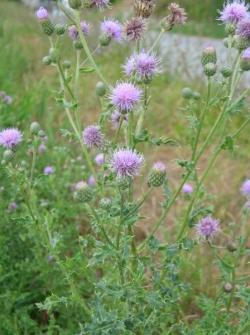
Week # 14
Spiny Invaders
As many as four varieties of Eurasian thistles are now distributed throughout the Okanagan-Similkameen, including Canada thistle (Cirsium arvense), bull thistle (Cirsium vulgalre), nodding thistle (Carduus nutans) and Scotch thistle (Onopordum acanthium). These thistles invade cultivated fields, pastures, roadsides and cut blocks, as well as natural grasslands, forest openings, streambanks and shorelines. While few places are immune from thistle invasion, these spiny plants prefer open, well-drained, sunny sites with loamy clay soils that are deep and moist.
Thistle is an old English name for a large group of plants with a dubious reputation. In ancient history, the thistle represented part of the primeval curse on the earth in general, and on man in particular. In Greek history, Earth made the thistle in a moment of grief for the loss of Daphnis. In Norse mythology, Thor protected the plant, known as the lightning plant, and all those that wore it from harm. In some translations, thistle is also the basis of Hans Christian Anderson's tale The Wild Swans, where eleven princes were freed from their entrapment as swans when their sister made shirts from thistle and placed them on their backs. Scotch thistle has regal stature. During the reign of Malcolm I of Scotland, Norsemen attempted to capture the Staines Castle by wading across the moat in their bare feet, only to find the moat dry and overgrown with thistle. The painful cries of the warriors roused the castle guards and the Norsemen were defeated. To commemorate this victory, the flower became the emblem of Scotland.
While we tend to focus on their negative characteristics, some thistles have many useful traits. Europeans, Native Americans, and early settlers found many thistle species edible, as well as useful for medicinal purposes. Raw thistle seeds are bitter but were often roasted before being eaten. The young leaves of Canada and bull thistle, with the spines removed, can be served as a salad or cooked like spinach. The inner stem pith can be steamed and served like asparagus, once the outer layer is peeled off. The heads of these plants also can be used as rennet to curdle milk for cheese making.
Though its name would indicate otherwise, Canada thistle is a native of the Mediterranean region and southeast Europe. It was one of North America’s earliest floral colonizers, arriving in contaminated hay and grain seed during the 17th century. In BC, Canada thistle is listed as a provincially noxious species and is the most aggressive and difficult to control thistle occurring in the Okanagan-Similkameen region. This creeping rooted perennial reaches a height of 1.2 metres. Canada thistle can be recognized by its stalkless, dark green leaves that have irregular spiny lobes and by its small spineless rose-purple to white flowers. Plants produce an average of 1,500 seeds annually, which are predominantly spread by wind. About 90% of the seeds will germinate within one year, but other seeds can remain viable for about 20 years. Unlike other thistles, the Canada thistle has a deep and wide-spreading root system. Small fragments of the roots can sprout new thistle plants, so the plant is especially troublesome in fields where it is spread by cultivation. Control efforts should focus on preventing seed production and attacking the roots.
As its name indicates, the purple flowers of nodding thistle nod or droop towards the ground due to their large size (2.5 to 5 cm across). Plants grow up to 2.5 metres tall with spiny and winged stems, except for below the flowerhead. As this species may act as an annual or biennial with an extensive seed output, the key to management is preventing seed production. Plants may be repeatedly cut, mowed or hand-pulled when mature, or dug out in the rosette or first-year stage.
Scotch thistle and bull thistle are biennial invaders that most closely resemble the native wavy-leaved thistle (Cirsium undulatum). Bull thistle is dark green and has deeply lobed leaves with long spikes. It is the only thistle with a spiny leaf surface. Plants grow upwards from 0.3 to 2.0 metres in height. Pinkish to dark purple flowers produce up to 4,000 seeds per plant. Scotch thistle is similar in colour to the native wavy-leaved thistle – a pale silvery green - however its overall form is much larger. Mature Scotch thistle plants range from 1.5 to 3.0 metres in height. The entire plant is spiky, with sharp yellow spikes on the large leaves, and spiny wings on the stems and branches. Plants produce large, solitary purple flowerheads. As both bull thistle and Scotch thistle are biennials, plants can be controlled in their second year by cutting mature plants at the base of the stem prior to seed production, or by digging-out plants during the rosette or first-year stage.
While there are a limited number of biological control agents or natural predators available for control of some thistles, bioagents unfortunately have yet to provide a substantial level of control. Introduced thistles continue to be a problematic species to landowners in the region. As with other invasive species, competition is a key component of battling the thistles. Minimizing soil disturbance and maintaining vigorous perennial plant communities can prevent new infestations. Disturbed areas should be seeded to perennial grasses to provide competition.
For anyone who wishes to view Weed of the Week articles on the Internet, note the Direct Link to the Invasive Plant Program on the home page of the RDOS website www.rdos.bc.ca. For more information on invasive plants, contact Lisa Scott, Invasive Plant Program Coordinator for the Okanagan-Similkameen Regional District at (250) 492-0237 or email info@rdos.bc.ca
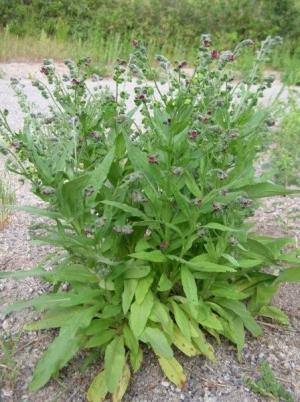
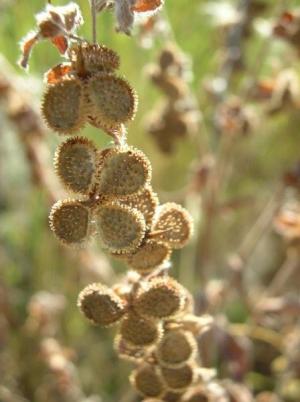
Week # 13
Hitchhiker Weed
An article last month focused on a common hitchhiker weed called burdock and I promised an article on another plant with a similar mode of spread. Hound’s-tongue (Cynoglossum officinale) is extremely abundant in the Southern Interior of BC. This invader harbors an abundance of viable seeds that are waiting for an opportunity to spread far and wide. It uses a unique mode of seed dispersal that entails hitching a ride on passing humans, wildlife, livestock and pets. Most residents of the Okanagan-Similkameen are probably all too familiar with the small tear-shaped seeds of hound’s-tongue, which readily attach to fur, clothing and footwear.
This Eurasian biennial invades rangelands, pastures, cut-blocks, disturbed habitats, ditches, stream banks and roadsides. In the Okanagan-Similkameen, hound’s-tongue is common in low to mid elevation grasslands and forests, as well as creek side (riparian) areas with moist, fertile soils and high nitrogen content. Once established, hound’s-tongue has the potential to out-compete native vegetation, negatively impacting wildlife habitat and livestock rangeland. Hound’s-tongue plants are toxic and may cause liver damage in grazing animals, especially horses and cattle. The seeds can also irritate skin and stress livestock, resulting in reduced sale values and potentially increased veterinary costs.
Many people are not familiar with this plant in its first-year stage, when it exists as large tufts of low growing leaves. Hound’s-tongue has distinctly tongue-shaped leaves, musky purple flowers and grows from 0.3 to 1.2 metres (1 to 4 feet) tall. Plants bolt and flower during their second year. Seed production begins shortly after flowering, typically yielding 2,000-4,000 seeds per plant.
Because hound’s-tongue reproduces entirely by seed, control efforts should be directed towards reducing seed output and preventing dispersal. You can help by checking clothing and pets when moving between weed-infested and weed-free areas. Ensure that seeds remain in the affected area. Landowners can also help by reducing soil disturbance and maintaining healthy lands with a vigorous population of desirable plants to provide ground cover. Disturbed soils should be re-seeded as soon as possible to provide competition and prevent invasive plants from establishing.
Effective control of hound’s-tongue is highly dependent on stage of growth. During its first year of growth, the growing tissue must be removed which means the top 3 to 4 inches of the roots must be dug-out. The taproot functions to store nutrient and energy reserves until the plant is ready to bolt the following spring. If plants have bolted and are blooming, there is no need to dig up the roots. Instead, at this stage, plants may be cut as close as possible to the ground. At this time of year when seeds are present, plants should be carefully clipped and bagged, then taken to the landfill. Composting will not necessarily kill the seeds, so plant material should be buried.
For large infestations, we are fortunate to have access to a very effective biological control agent or natural insect enemy. A small oval-shaped and blackish brown beetle referred to as Mogulones cruciger is noticeably reducing populations of hound’s-tongue throughout the Southern Interior. The beetles were given their Latin ‘species’ name – cruciger – due to the white cross that is marked at the center top of the wing covers. Young beetles, or larvae feed primarily on the root; however, if food is short they will attack any part of the hound’s tongue plant. Mature adult beetles feed heavily and reproduce throughout the summer months. The combined attack of the beetles at all their life stages decreases the plant’s strength, as well as reproductive and competitive ability. As a general rule, biological control reduces weeds to a point where infestations are at a balance with their natural enemies, or from our point of view, a more environmentally and economically acceptable level. We have in fact established a site north of Princeton at Allison Lake where we are breeding this beetle, with the hopes of collecting and redistributing this insect beginning in 2010.
And for anyone who has not yet entered our Invasive Plant Photo Contest, you have more time to do so. We have extended the deadline for submitting entries to October 15. So take advantage of this beautiful weather to head outdoors and take some shots of your favorite (or least favorite!) invader. There are categories for adults and youth with some great prizes to be won. For more details, go to our website www.rdos.bc.ca or drop into the regional district office at 101 Martin Street.
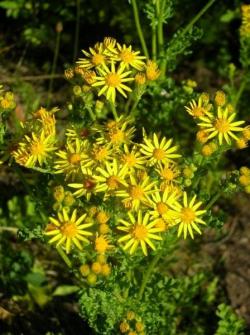
Week #12
Tansy Ragwort
Having spent the past few weeks vacationing on the Oregon coast, one would think that invasive plants were far from my thoughts. However, anyone who pays attention to plants during their travels has probably noticed that weeds know no boundaries and no place is immune from their establishment. So it was not surprising that I noted a few invaders during my holidays. The most conspicuous species I observed along Oregon’s coastline was tansy ragwort (Jacobaea vulgaris), an invasive plant that also occurs in the Okanagan region.
Tansy ragwort is a biennial to short-lived perennial plant in the Sunflower family. A low-growing rosette of leaves is produced in the first year. Upright stems growing 0.3 to 1.2 metres (1 to 4 feet) high are produced in the second and often subsequent years. The dark green, stalkless leaves are deeply cut into irregular segments giving the plant a “ragged” appearance for which it is aptly named. Because of its undesirable odour it is also known as Stinking Willie. People often confuse tansy ragwort with common tansy (Tanacetum vulgare). Common tansy can easily be differentiated by its lack of ray flowers and sharply toothed, fern-like leaves.
The daisy-like, bright yellow flowers, evident from July through September, produce an abundance of seed that is transported by wind, water and animals. The tiny seeds may also be transported in mud that is caught in the tire tread or undercarriage of vehicles. One ragwort plant can produce in excess of 150,000 seeds. Seeds can lie dormant on the soil surface for 4 to 5 years or over 20 years if buried. Seeds germinate in both spring and fall to form new rosettes.
Tansy ragwort prefers open, sunny locations with disturbed soils, such as roadsides and cut-blocks, but will also readily dominate pastures, forest edges and riparian habitats where it competes with desirable vegetation. Harmful alkaloids concentrated in the flowers can cause liver damage to cattle, horses, deer and pigs, leading to death with persistent exposure. Sheep appear to be less affected as they can daily graze on young tansy ragwort plants without suffering any ill effects. This poisonous weed is not preferred forage and animals will usually try to avoid it in a pasture if more desirable forage is available. Poisonings most often occur as a result of feeding contaminated hay or silage, or in spring pastures when young rosettes cannot be selectively avoided as grass and clovers are grazed.
This particular weed emerged as a threat to the Pacific Coast in the mid-1850s, making its way from California after being introduced to North America. Tansy ragwort is native to Europe, Asia and Siberia, thriving in cool, wet coastal habitats. However, it managed to find its way to B.C.’s dry interior where it was detected approximately 20 years ago in the Chute Lake area, northeast of Penticton. Until last year, this was thought to be the only location in the interior of the province that supports this weed and it just so happens to be the largest single infestation of tansy ragwort in B.C. Unfortunately, the size of the infestation is estimated to have quadrupled in size since its initial discovery in the late 1980s. And equally unfortunate, a new infestation was discovered in West Kelowna last summer, near Crystal Mountain. We cannot know for certain how it got here, but this speaks to the importance of making everyone aware of the need to pay attention to invasive species and report new occurrences.
Experts are closely monitoring this weed and attempting to thwart its spread, particularly following the Okanagan Mountain wildfire of 2003, which has unquestionably helped to facilitate the range expansion of tansy ragwort. A few patches were discovered in the upper Carmi area, east of Penticton, about five years ago. Efforts to control tansy ragwort are hampered by its pervasiveness due to a persistent seed bank and its ability to resist biological control agents (introduced natural enemies). However, this summer, researchers with the Ministry of Forests and Range noted that one of the four different insects released in the Chute Lake area appears to be thriving. This discovery is very exciting, as most of the insect species have not survived, presumably due to climate changes as they have been imported from the coast. The seemingly successful biocontrol agent is the Cinnabar Moth, an attractive bright red and brown/black moth that is capable of completely defoliating plants. It is host specific and only attacks tansy ragwort.
Interestingly enough, tansy ragwort was extensively prescribed in medieval medicine although literature suggests some contradiction as to whether or not ailments were truly cured by this herb. It was used to help aches and pains in arms, hips, and legs when it was boiled in hog's grease to the form of an ointment. It was used to treat coughs, colds, and also sores and cancerous ulcers - hence one of its old names, Cankerwort. It was additionally used to relieve rheumatism, sciatica and gout, a poultice of the green leaves being applied to painful joints to reduce inflammation and swelling. It made a good gargle for ulcerated throat and mouth, and is said to take away the pain caused by the sting of bees. In olden days it was supposed to help the ‘Staggers in Horses’, resulting in one of its popular names, Staggerwort. It has also been referred to as Sleepy Weed for inducing slumber and Stammerweed because of a misguided belief that taken as a tea it could cure stuttering, though possibly its toxicity had been observed to interfere with speech for whoever over-imbibed. However, because its dangerous toxins are difficult for the body to expel and can accumulate in the body, tansy ragwort is not favored by herbalists for use in today’s medicine.
If you have small patches or individual ragwort plants on your property, they can effectively be controlled by hand pulling, ideally prior to seed production. Plants that have gone to seed should be clipped and bagged. Please report any possible sightings of this invasive plant by contacting the Regional District office in Penticton.
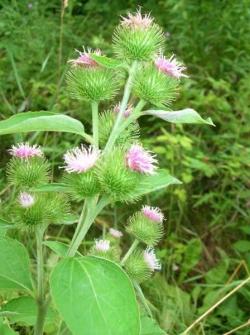
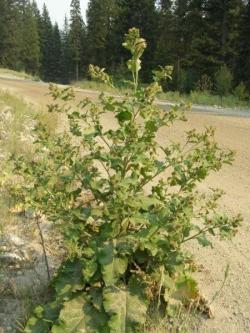
Week #10
Nature’s Lethal Velcro
This week’s article focuses on an invader that I remind people about every year, as it seems to have gone under the radar for quite some time. And yet it can be deadly for our wildlife species and poses health concerns to livestock.
Ever wondered where the concept of velcro came from? Well that credit goes to one of our more common invasive plants, burdock. There are two types of burdock in the Okanagan-Similkameen, both of which are European biennials. Common burdock (Arctium minus) is the most frequently occurring species, growing 1 to 3 metres in height. Flower heads are less than 2.5 centimetres across and scattered along the stems. The lower leaf stalks of common burdock are hollow. Great burdock (Arctium lappa), sometimes called giant burdock, is similar in appearance but lower leaf stalks are solid and flower heads are over 2.5 centimetres across and arranged in a flat-topped cluster rather than along the stem. It is quite rare in southern BC. Both species appear as rosettes during their first year, then grow tall producing purple blooms during their second year. They are quite noticeable right now, as plants have bolted and are starting to flower. The rhubarb-like leaves are very large with wavy margins. Most distinguishing about burdock and the link to velcro are the seed heads. The flower heads of burdock have many thin, hooked spines or bracts, which become a large sticky mass in mid-summer. Burdock flower heads readily get entangled in clothing and animal fur, aiding plant dispersal. In 1941, a Swiss engineer named George de Mestral took a close look at the flower heads, which kept sticking to his dog’s fur on their daily walks in the Alps during the summer. He examined their condition and saw the possibility of binding two materials reversibly in a simple fashion. He developed the hook and loop fastener and submitted his idea for patent in 1951. The end result – velcro!
For some of our smaller wildlife species, burdock has proven to be deadly. This plant has undoubtedly been claiming the lives bats and small birds for several decades. I receive at least a couple reports each year of bats found stuck on the seed heads. More recently, I have learned about songbirds and hummingbirds also being caught on burdock. The large number of hooked spines on every seed head apparently traps these helpless animals, which are unable to break free and any attempt to do so only results in further entanglement. Livestock are also affected by burdock, as the spines can result in eye infections in horses and cattle, while the sticky seed heads can also irritate skin and stress animals, resulting in reduced sale values and potentially increased veterinary costs.
In the Okanagan-Similkameen, burdock is common in farmyards, along fence lines, roadsides, as well as creek side (riparian) areas with moist, fertile soils and high nitrogen content. As with other non-native plants, burdock has an advantage over our native plants because it lacks enemies, and therefore has a competitive edge. When the native plants are displaced, the animals that feed on them are forced to move elsewhere to find food, which diminishes their habitat.
Because burdock reproduces entirely by seed, control efforts should be directed towards reducing seed output and preventing dispersal. You can help by checking clothing and pets when moving between weed-infested and weed-free areas. Ensure that seeds remain in the affected area. Landowners can also help by reducing soil disturbance and maintaining healthy lands with a vigorous population of desirable plants to provide ground cover. Disturbed soils should be re-seeded as soon as possible to provide competition and prevent invasive plants from establishing.
Effective control of burdock is highly dependent on stage of growth. During its first year of growth, the growing tissue must be removed which means the top 3 to 4 inches of the roots must be dug-out. The taproot functions to store nutrient and energy reserves until the plant is ready to bolt the following spring. If plants have bolted and are blooming, there is no need to dig up the roots. Instead, at this stage, plants may be cut as close as possible to the ground. If plants have gone to seed, they should be carefully clipped and bagged, then taken to the landfill. Composting will not necessarily kill the seeds, so plant material should be buried.
Burdock is not the only sticky plant growing in the region. Others hitchhikers include hound’s-tongue (which I will highlight in an upcoming article), western sticktight, cleavers and catchweed.
Western sticktight (Lappula occidentalis) is an annual native to the western plains region. It grows up to 30 centimetres tall and produces many small, white to blue flowers. The leaves are quite narrow and the stem is very branched. Western sticktight is named for its seeds, which can stick to clothing and fur.
Cleavers (Galium aparine), also known as catchweed bedstraw, is another North American annual. It has square stems with downward pointing bristles. The leaves are in whorls of 6-8 and also have stiff hairs. Very small white flowers are borne on short branches in the leaf axils. The fruit is two rounded halves and is covered in fine, hooked hairs. This weed is a problem in cultivated fields, where it sticks to, and tangles into the crop. The small fruits also cling to clothing, fur and feathers. I recall a few years ago, transporting a very distressed long-eared owl to the rehabilitation centre in Oliver. This owl was so completely covered in cleavers that it was unable to fly.
Catchweed (Asperugo procumbens) is a European annual. It grows like a vine due to its weak stem. The stem and leaves are covered in small, stiff hairs that can catch on to clothing, fur and animals. The flowers of catchweed are small and deep blue or violet. This species is becoming a common sight in waste places and cultivated areas, as well as on roadsides.
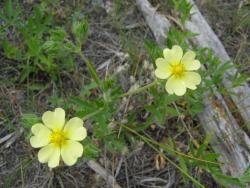
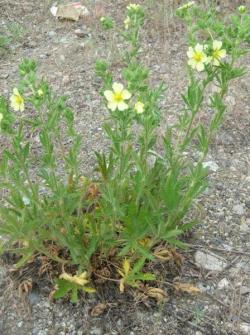
Week # 9
Sulphur Cinquefoil
Thanks to all those readers who have been reporting sightings of buffalobur, the plant I focused on in last week’s article. This week I am highlighting another yellow flowering invader, but unfortunately this species is much more widespread and is significantly impacting our grasslands and lower elevation forests. I am speaking of sulphur cinquefoil (Potentilla recta), a native of Europe, Asia and northern Africa, which was introduced into North America before 1900. It is established across much of the United States and southern Canada. It occurs from British Columbia east to Newfoundland and Nova Scotia, south to Florida, and west to eastern Texas.
This long-lived perennial infests disturbed areas, meadows, pastures and rangelands and can dominate a site within two to three years of first appearance. Its seeds are spread by grazing ungulates, especially deer and elk, as well as human activities, including ATV and off-road recreation. Recent increases in sulphur cinquefoil density may also be associated with density reductions in knapweed, due to stress resulting from attack by biological control agents (natural insect enemies).
In British Columbia, sulphur cinquefoil is most common in the Southern Interior, where it has become rapidly abundant in the last decade. The insidious nature of sulphur cinquefoil poses both a significant environmental and economic threat. Once established, this weed can produce dense populations that reduce or eliminate forage production and biodiversity. It is unpalatable to most livestock and wildlife due to a high concentration of bitter tasting compounds.
Sulphur cinquefoil is a member of the rose family (Rosaceae), and is one of over 20 herbaceous cinquefoils in BC. Plants grow upright, reaching heights of 15-70 cm, with one or more hairy stems. Leaves are divided into 5-7 hairy, toothed leaflets, each 5-10 cm long. Flowers are pale yellow with five heart-shaped petals around a bright yellow centre. Sulphur cinquefoil most closely resembles graceful cinquefoil (P. gracilis), a native plant which is shorter, has white woolly hair on the undersurface of the leaves, more basal leaves, deeper and less uniform leaf serrations, and bright yellow flowers.
Sulphur cinquefoil grows very early in the spring from a woody root. The plant begins blooming in mid-June and produces flowers throughout the summer if growing conditions are favourable, until setting seed in late July. Above-ground portions of the plant completely dry up by late August but fall re-growth of bottom leaves is possible under moist, mild conditions.
As with all invasive plants, prevention is number one. Due to its aggressive tendencies and challenges in controlling, this is one species you are best preventing from invading your property. This can be accomplished by maintaining your land in a healthy, vigorous condition to ensure a productive plant community. Competitive perennial grasses and forbs utilize water and nutrients that would otherwise be readily available to cinquefoil. Cooperate with adjacent landowners and encourage them to control sulphur cinquefoil. Reducing soil disturbance is also important, in addition to immediately re-seeding disturbed, bare soils with a suitable seed mix that provides dense, early colonization to reduce weed invasion. Hand pulling, with regular follow up, can be effective on new and small infestations.
Unfortunately, no biological controls have been approved for sulphur cinquefoil in North America and chances of ever getting approval are slim. Acceptable agents are difficult to find because insects and diseases damaging to this weed may also attack closely related cinquefoils or strawberry plants, which are also a close relative.
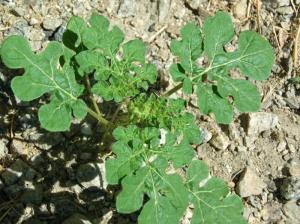
Week # 8
Spiny Buffalobur
Last year I introduced readers to a spiny invader that generates some interest from local gardeners every summer. Not surprisingly, reports of this unique weed have started already so I thought it would be timely to include another article on this plant.
The culprit I am speaking of is buffalobur (Solanum rostratum), also known as Kansas thistle, Texas thistle or Colorado bur. The range of this North American annual extends from Central Mexico northward across the Great Plains of the United States. The name buffalobur dates back to the time of settlement of the Great Plains when the plant grew abundantly in the disturbed soil of buffalo wallows. Buffalo carried the burs great distances in their shaggy coats.
Repeatedly introduced into the Pacific Northwest, buffalobur usually appears in gardens, where it was planted with flower or vegetable seeds. Occasionally, plants sold as tomato seedlings have matured into buffalobur, although the plant is in fact a member of the potato family. Additionally, a press release issued in 2006 by the Department of Agriculture in the State of Idaho listed buffalobur as a regular contaminant of domestic or wild bird feed mixes. There are also reports of this weed showing up on re-seeded rangeland in the Penticton area.
Despite the frequent, repetitive introductions into the Pacific Northwest, particularly central and eastern Washington, buffalobur has never become established. Its failure to establish in Washington is due to aggressive control measures taken against the plant rather than its lack of ability to survive in this state. It is known to be highly aggressive and invasive in its native range. Buffalobur grows in cultivated fields, pastures, dry rangeland, roadsides and other disturbed areas. Although it is adapted to sandy soils, it will also grow on dry hard soils to rich moist soils of cultivated fields.
The stems are upright and bushy, mostly branching in the upper part and reaching heights of up to 60 cm (2 feet). Except for the flower petals, the entire plant is covered with straight yellow spines that can be over one cm (1/2 inch) long. The leaves are alternate and 5-15 cm (2-6 inches) long, including the stalks. Each leaf is irregularly cut into five to seven lobes and is covered by short yellow star-like hairs, and the midribs, veins and leaf stalks are spiny. The yellow flowers are five-lobed, wheel-shaped, 2.5 – 4 cm (1 to 1.5 inches) across, in few flowered clusters on spiny flower stalks. The plants bloom in late June to early August and the seeds mature from July to October. To identify buffalobur, look for the tomato-like yellow flowers and the unique, extremely prickly leaves, stems and fruits.
While the plant is physically imposing, it is not very competitive and survives only in disturbed, dry areas. I don’t foresee buffalobur ever becoming a problem in the Okanagan, however its certainly one worth paying attention to because of its many undesirable properties. Its sharp spines may injure grazing animals and people. It completes with forage and other crop plants for moisture.
If you discover buffalobur on your property, don’t grab it, or you will be rewarded for your bravery by receiving a hand full of spines. Individual plants or small patches should be hand-pulled using leather gloves or by hoeing before blossoms appear. Plants with seeds should be carefully bagged and taken to the landfill for disposal. Infestations occurring in a pasture situation should be controlled to make sure that the plant does not contaminate hay. I would appreciate notification of any additional sightings of this invader.
For more information on invasive plants, contact Lisa Scott, Invasive Plant Program Coordinator for the Okanagan-Similkameen Regional District at (250) 492-0237 or email info@rdos.bc.ca
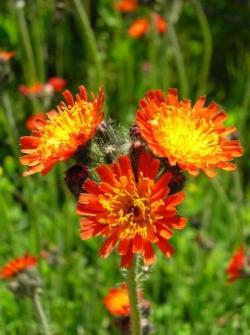
Week #7
Hawkweed Alert
In recent weeks, I have been doing invasive plant assessments at mid to high elevation sites around the Okanagan Valley. In addition to invasive plants, it is a great time to view wildflowers such as lupine, paintbrush, tiger lilies and columbine. However, there may be some yellow and orange flowering plants in this mix that at first glance, do not appear troublesome.
I am speaking about hawkweeds. There are several varieties of hawkweeds growing in our region, with close to half of the species being non-native. Invasive hawkweeds are among the most troublesome weeds in the Pacific Northwest region, yet we are only just realizing the severity of the problem. The first species arrived to the region as recent as fifty years ago, probably from the western expansion of infestations from eastern Canada and the U.S. shortly after the Second World War.
Hawkweeds are members of the genus Hieracium, which consists of between 700-1000 perennials. Hawkweed is a slang name taken from folklore which says that hawks would chew on the brightly coloured plants to improve their eyesight. There are approximately eight native hawkweeds in BC and 13 invasive hawkweeds. All but one native species have yellow flowers, the exception being white hawkweed, which is fairly common in our region. Similarly, all but one invasive species has yellow flowers. The uniquely coloured invader is orange hawkweed (H. aurantiacum), aptly named due to its bright orange flowers. Several hawkweed species are popular ornamental plants, particularly orange hawkweed. They have been and continue to be spread by intentional and accidental human activities.
Hawkweeds are fibrous rooted, perennial herbs growing from a stout rhizome. Plants reproduce by seeds, and vegetatively by stolons, rhizomes and adventitious root buds. The small dandelion-like heads are borne singly at the top of a long stem or in compact, rounded or loose clusters. While their brightly coloured flowers are quite an attractant during the summer blooming period, the hawkweeds are difficult to detect when not in bloom due to the leaves being predominantly located at the base of the plant.
Hawkweeds are pros when it comes to being invasive – they have high seed production, high germination rates, long distance seed dispersal, and spread from root fragments, root buds, stolons and rhizomes. In addition, they have a very rapid generation time with one plant able to produce as many as 700 root buds in as little as 63 days! Pretty impressive. Unfortunately, this equates to an ability to rapidly invade open fields, pastures, mountain meadows, clearings in forest zones, abandoned pastures, roadsides and other modified habitats where the soil is well drained, coarse-textured and moderately low in organic matter. On a positive note, hawkweeds do not appear to invade our dry, natural grasslands, which are already under tremendous development pressure and vulnerable to invasion by virtually hundreds of other invasive plants.
Hawkweeds occur most commonly at low to mid elevations, but have been discovered at altitudes in excess of 1700 metres (5500 feet). In our region, invasive yellow hawkweeds have primarily been observed growing on roadsides located on the east side of the Okanagan valley, from areas above Okanagan Falls north to the Okanagan Mountain / Chute Lake area. Tall hawkweed (H. piloselloides) seems to be the most common invader, although infestations of queen devil hawkweed (H. praealtum) have also been discovered above Penticton. Orange hawkweed, although limited in abundance, appears to have a somewhat more widespread distribution. To date, the largest infestations of this weed are in the Chute Lake area, while isolated patches occur around Penticton, Keremeos, Princeton and Summerland. In recent years, I have been surprised at the number of landowners admitting to having this eye-catching plant in their garden or else reporting invasions of orange hawkweed growing in neighboring backyards.
So how to control hawkweeds? As with every other invasive plant, prevention is your number one tool. Learn to identify the hawkweeds and monitor your property annually for new invaders. Check sources of fill, gravel, hay and seed for potential contaminants. Clean vehicles and equipment that have been in hawkweed areas. Maintaining a healthy vegetative cover helps to avoid initial infestations. If hawkweeds are present on your property, plants can be cut and pulled but these methods are ineffective unless done with frequency and diligence to eliminate re-growth. In agricultural situations, hawkweed plants will not withstand regular tillage. There are presently no biological control agents available, however research is ongoing.
For those of you who have had some difficulties finding previous weed of the week articles, note the new direct link to ‘Invasive Plants’ on the home page of the regional district website www.rdos.bc.ca. You will also find information on our invasive plant photo contest.
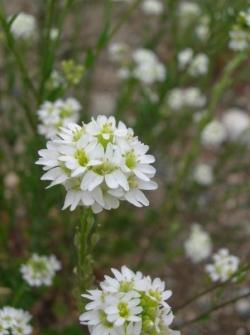
Week #6
Harmful Mustard Deserves Attention
Before delving into the ‘weed of the week’, I would like to bring attention to our recently announced invasive plant photo contest. So all you shutterbugs get out your digital cameras and start getting up close and familiar with our invasive species. Many invaders are in full bloom right now and we would like to see your best photographs. There are categories for adults and youth with some great prizes to be won. For more details, go to our website www.rdos.bc.ca or drop into the regional district office at 101 Martin Street.
This week I decided to focus on another white-flowering plant that is on the move in our region. Hoary alyssum (Berteroa incana) is an annual to short-lived perennial that originated in Eurasia and is a member of the mustard family. It occurs in the Okanagan, Thompson and Kootenay regions, as well as across southern Canada in general. Of these areas, it has been classified as a noxious weed in the Kootenay-Boundary region, as well as in Washington State.
Hoary alyssum can be found in various locations throughout the Okanagan-Similkameen region and is particularly evident right now as it is in full bloom. It prefers dry sandy or gravely soils and establishes well in dry, disturbed habitat such as pastures, hayfields, roadsides and embankments. The plant emerges as a rosette in early spring and then bolts and grows a cluster of white flowers (June to September) that it continues to produce until frost. When acting as a perennial it over-winters as a rosette and emerges again in the spring. Flowers are carried on slender stalks that reach up to 70 cm (2-3 feet) in height. It has flattened oval seedpods that are chambered and can contain anywhere from 3-7 seeds aligned in rows. It is distinguished from other mustards with oval or rounded seedpods by its stalkless, non-clasping stem leaves with smooth margins, the dense star-shaped hairs that cover the entire plant.
Hoary alyssum plants can vary in form considerably depending on site-specific conditions such as soil type, nutrient availability, moisture, and competition. These variables may cause them to be simple, slender and unbranched, to partially branched, or even fully branched and rounded to the appearance of tumbleweed.
Of immediate concern is the fact that hoary alyssum is toxic to horses, causing swollen legs, laminitis (a very painful condition of the foot) and severe lameness. Consumption of large quantities can cause diarrhea, leading to dehydration, and can cause abortions in pregnant mares. Hoary alyssum is toxic when the fresh plant is grazed in a pasture and when the dried plant is eaten in hay, although most hoary alyssum toxicity occurs when horses accidentally ingest it in hay. Hay containing greater 20 percent or more hoary alyssum should not be fed to horses. I strongly encourage horse owners to thoroughly inspect sources of hay to ensure that hoary alyssum and the myriad of other potentially toxic plants are not present in or near pastures and hayfields. Well-maintained pastures will provide suppression of hoary alyssum through competition.
To effectively battle this invader, the first plants found in an area should be destroyed before seedpods begin to form which means taking action now. Small populations can be killed by hand pulling, digging or hoeing. While mowing can be used to prevent seed production, it is not an effective approach as the hoary alyssum typically re-grows as a much larger and robust plant. Infested sites or those vulnerable to invasion should be monitored annually and new plants removed before seed production. Ideally, infested areas should be re-vegetated with competitive, beneficial plants for effective management. Plants should be disposed of by burial at the landfill if seedpods are present. There are no biological controls for hoary alyssum available at this time.
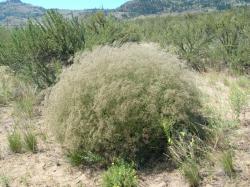
Week #5
Not So Innocent Baby’s-Breath
While driving home from a popular Summerland beach last weekend, I told my daughter to roll down her window and take a deep breath. “Yuk! What is that awful sweet smell?” she asked. Many people are asking me that these days and are surprised to learn it is baby’s-breath (Gypsophila paniculata), an herbaceous perennial from Europe and Asia.
Mention baby’s-breath and most people think of the cut flowers in bouquets or ornamental plants in gardens. The most commonly encountered garden variety in our region is the perennial species, however the annuals G. elegans and G. muralis are also common ornamentals in North America. They are easily propagated from seed, by cuttings or by root division before growth starts in the spring. Starting as a tiny seed, the annuals and perennials germinate in ten to fifteen days, and can grow rapidly up to 1 metre in height. When these qualities are combined with a deep, thick penetrating root system with abundant food reserves (in the case of the perennial variety), this makes for a highly invasive and persistent species.
Baby’s-breath has widely branching stems and narrow, pointed leaves that grow in opposite pairs. By the time the plant flowers, most of the leaves are gone. The flowers, which are white to pink with five petals, are produced in diffusely branched clusters. It reproduces only by seed and while most seeds drop next to the parent plant, some are carried by the wind up to one kilometre. A mature plant can also break off at the base and tumble in the wind for seed dispersal. One plant can produce up to 13,000 seeds.
The large white puffballs of baby’s-breath are clearly evident right now on our grassy hillsides, along roadsides, vacant lots, trail edges and other disturbed sites. Once established, baby’s-breath is able to out-compete native perennial plants and can form dense thickets. It can infest pastures and rangeland areas, and make its way into hay, where it significantly reduces crude protein content in desirable grasses for grazing animals. It can also be a host for several viruses. Once mature and dried, most view baby’s-breath as unsightly, particularly when it tumbles across vacant lots and along fence lines. And a large dry patch of baby’s-breath is unquestionably a fire hazard.
Baby’s-breath prefers alkaline soils, like lime, hence the Latin name Gypsophila; “Gypsos” meaning lime, and “philos” meaning loving. It does not tolerate acidic soils. While baby’s-breath can grow in both fine textured and coarse textured soils, it prefers coarser soils to facilitate its extensive root system development. In Canada, baby’s-breath is most prolific in areas with low rainfall.
Baby’s-breath was introduced to North America over a century ago and has been present in BC for several decades. However, it is only in recent years that baby’s-breath has been thought of as an invasive species. Up until about a decade ago, it was commonly harvested in the Okanagan, then dyed all sorts of gaudy colours and shipped to locations across Canada. This once thriving industry seems to be non-existent these days, which at the time kept this invader somewhat in check. In fact, there has been a very noticeable increase in the abundance and expanse of baby’s-breath in the Okanagan in the past decade.
Understandably, this plant will not lose its floral industry value any time soon, but care should be taken so that it does not decrease the value of our natural habitats. For those landowners who are looking to keep their properties free of baby’s-breath, prevention is key. Maintaining a strong population of native perennials is the best method for preventing establishment. As disturbed soil is a welcome mat for any invasive plant, not just baby’s-breath, soils should be seeded immediately following a disturbance. If it does manage to invade your property, remove baby’s-breath immediately before it becomes too overwhelming or difficult to control. Removing it from your garden and replacing it with a native plant or non-invasive ornamental can help stop its spread. Plants must be dug out of the ground, as mowing and pulling can prevent seed production but will not kill them. Unfortunately there are no biological control agents or natural insect enemies for baby’s-breath.
Since mature baby’s-breath can tumble in the wind and roll onto roadways, it can be transported to new sites by vehicles. When leaving an infested area be sure to check your car or truck for baby’s-breath or weeds caught in the undercarriage. Although it may be tempting, refrain from picking the plants from roadsides and other disturbed areas, as you may be contributing to the rapid spread of this invader.
I’ve made mention of this invader in previous articles, and stressed the need to avoid purposeful planting of this ornamental. I have also encouraged gardeners to avoid wildflower mixes that contain the perennial variety, although baby’s-breath can also be a regular contaminent of such seed mixes. However a new and unexpected means of spreading this plant came through the discovery of bars of soap that come in 100% post consumer recycled packaging imbedded with baby’s-breath seeds. The instructions are to plant the carton in soil, water and watch the plants grow. Yikes! What next?!
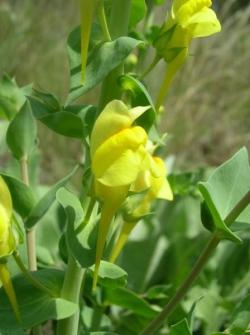
Week #4
Daunting Dalmatian Toadflax
Many thanks to those readers who have contacted me with sightings of knotweed, which I wrote about last week. While it is not surprising, it is somewhat distressing to learn of these new occurrences that I had no idea existed. So please continue to report sightings to me. This week’s article will focus on another escaped ornamental, but this plant is a much more widespread species. Despite being so ubiquitous, Dalmatian toadflax (Linaria dalmatica) still deserves some attention.
Dalmatian toadflax, also known as broad-leaved toadflax, is native to the Mediterranean regions of Europe and western Asia. In BC, this escaped ornamental plant occurs most frequently in the Southern Interior region of the province where it invades open, low-elevation, coniferous forests and grassland habitats. It is most commonly found on sandy or gravely soil on roadsides, railroads, pastures, cultivated fields, rangelands and clear cuts. While toadflax can rapidly colonize disturbed or cultivated ground, plants can also invade healthy native plant communities.
This creeping-rooted perennial is a member of the figwort family. It typically reaches heights from 0.5 to 1.2 metres and is most easily recognized by its bright yellow “snapdragon-like” flowers. Leaves are waxy, light green and heart-shaped, and they clasp the stem. Yellow or common toadflax (L. vulgaris) is a closely related species that can be distinguished from Dalmatian toadflax but its shorter stature (it grows only to 0.6 m tall) and it has leaves that are long, narrow and pointed at both ends. The flowers also have an orange spot on the lower lip. Yellow toadflax is much less common in the Okanagan-Similkameen, with the largest infestation at the Nickel Plate mine site and small, isolated patches near Twin Lakes and in the Princeton area.
Dalmatian toadflax reproduces by seed and vegetative propagation, with individual plants living up to five years. Toadflax plants begin emerging in early spring, with flowering occurring from May-August and seeds maturing from July-October. A mature plant can produce up to 500,000 seeds annually, and they can remain viable for up to ten years. Prostrate stems emerge in September; they are tolerant of freezing and are associated with floral stem production the following year. Root buds can form on fragments as short as 1 cm in length and as early as 2-3 weeks after germination. These buds can grow their own root and shoot systems, and become independent plants the next year.
A persistent and aggressive invader, Dalmatian toadflax has expanded significantly in the western United States and western Canada during the last few decades. Toadflax displaces native vegetation, thereby altering the species composition of natural communities. It is a strong competitor, quickly colonizing open sites, and adapting to a wide range of environmental conditions. Once Dalmatian toadflax becomes established, it is particularly competitive with winter annuals and shallow-rooted perennials.
While some researchers claim that Dalmatian toadflax is toxic to livestock when consumed in significant amounts, reports of livestock poisonings are rare. Ungulates such as deer and bighorn sheep reportedly graze prostrate shoots in fall, winter, and early spring, and horses are suspected of feeding on mature plants. Dispersal probably occurs as seed pass through the gut or are caught in the hair of these animals, as well as by birds and water.
Residents of the Okanagan-Similkameen who have lived here for a decade or so, may have noticed a significant reduction in the distribution and abundance of Dalmatian toadflax during the past several years. I am quite certain that this is due to effective biological control or natural insect enemies. Several biological control agents have been released in BC, the most successful being a black, stem-boring beetle, Mecinus janthinus. Adults of this bioagent feed on new shoots and create “shot holes” in the leaves, while larva feed from within the plant, damaging the internal growth tissues. During the last few years however, we have observed a resurgence of this invasive plant. Our grasslands, open forests, roadsides and walking paths have been seemingly reinvaded by toadflax. While the immediate instinct of some people may be to hand pull plants or request the release of additional beetles, I discourage both of these actions. One needs to remember that biocontrol is a cyclical process that was never intended to eliminate weeds completely. The intent of biological control is to reduce weed populations below a desired threshold, where it is no longer creating a significant economic or ecological impact. Annual climatic changes can alter this predator-prey relationship. So even though we are seeing lots of flowering toadflax, this does not mean that our beetles have abandoned us. They are present but in low numbers, due to the reduction of toadflax in recent years. The beetle population will naturally increase in the coming years, in response to the increased amount of toadflax. Therefore, releasing more bioagents is unnecessary and pulling plants will only reduce opportunities for the beetles to reproduce this year. Pulling can also cause excessive soil disturbance due to the extensive root system. If you still feel compelled to take action, you could clip the seed heads to prevent seed production this year. However, this is not a necessary action and it is very labour intensive.
If your property supports individual plants or small patches of this invader, you can successfully control and eliminate toadflax by hand pulling, which works particularly well in moist or sandy soils. You will likely need to repeat this process over several years to deplete the seed bank. And remember to consider replacing these plants with a more desirable species, to avoid the site being re-infested by toadflax or yet another invasive plant.
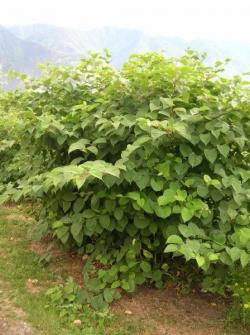
Week #3
Invasive Knotweeds
This week I will focus on what I view is the most impressive of our province’s top 13 “unwanted” horticulture plants for the southern region of BC - invasive knotweeds. Although the primary knotweed species found in BC is Japanese knotweed (Fallopia japonica), Bohemian knotweed (Fallopia x bohemica), Giant knotweed (Fallopia sachalenensis), and Himalayan knotweed (Polygonum polystachyum) are also present and all four species are considered invasive. Since all four species are similar in appearance, biology, impacts, distribution and methods of control, they will be discussed under the general title of “knotweeds”.
Invasive knotweeds are native to eastern Asia in Japan, China and Korea, and have spread at a rapid rate because of their lush ornamental appeal to gardeners, persistent root system and ability to adapt to a wide range of habitats. There is no doubt that invasive knotweeds have an exotic appeal. The vivid green foliage and hollow stems with distinct raised nodes give knotweed the appearance of bamboo, which it is commonly marketed as, although it is not closely related. But don’t be deceived; knotweeds are feisty, forceful and resilient to most control treatments.
Invasive knotweeds are herbaceous perennials that prefer moist habitats and freshly disturbed soils, but are capable of thriving in gravel and pavement landscapes and in sun or shade. The hollow stem is covered in a reddish-brown speckled papery sheath and will grow 1-5m in height. They will reach their full height by the end of June. Knotweeds have small white-greenish or light pinkish flowers in showy plume-like branched clusters. Japanese knotweed leaves are heart or triangle-shaped and zigzag along the arching stems whereas Himalayan knotweed has long-tapered leaves.
Japanese knotweed has received the greatest attention around the world and is listed amongst the “World's 100 Worst Invasive Alien Species” by the World Conservation Union. It can be found in 39 U.S. states and in six Canadian provinces. In the U.S. it is listed as an invasive weed in Ohio, Vermont, Virginia, New York, Alaska, Pennsylvania, Oregon and Washington state. This species is also common in Europe. In the United Kingdom it was made illegal to spread Japanese knotweed by the Wildlife and Countryside Act of 1981. Why has Japanese knotweed earned such a notorious status? Here are some facts that are mind-boggling. First off, it is capable of growing as much as 10 cm per day. It is a highly invasive plant and is capable of exposing weaknesses in buildings, foundations, concrete and tarmac. Japanese knotweed has the capability to regenerate from rhizome as small as 0.4 g; therefore it poses a massive risk of spreading via groundwork and disturbance.
All knotweeds are very efficient at spreading in part because they use their root system and can propagate vegetatively. A broken piece of a rhizome, as small as 2 cm, can form a new plant colony with shoots that sprout all along its rhizomes. Think of how many new shoots a plant can have if its roots can grow 3 meters vertically and up to 20 meters horizontally. Interestingly, even though in their native range they reproduce by normal bisexual flowers, they can also have plants that are solely female and that do not propagate by seed. Seed dispersal is minimal as there are more female than male plants and each species of knotweed is predominantly one sex. Japanese knotweed here in B.C. and all over Britain is an example of all the plant parts being female. So essentially a thicket of Japanese knotweed is one single female!
We have discovered several occurrences of knotweed in Keremeos, Penticton, Oliver and Summerland during the past year. Not surprisingly, most plants have been purposefully planted. This is something that we are striving to change across BC, as the invasion of knotweeds into a landscape has many negative economic, ecological and aesthetic impacts. Because knotweeds are so hardy and spread aggressively, they are capable of blocking access to waterways, reducing sightlines along roads and fences, shading out native plants, dominating riparian areas and increasing soil erosion. And lets not forget about that potential to undermine your building foundation.
Preventing the spread of knotweed starts with being able to identify the plant and avoid planting it in your yard. Controlling the spread or managing existing knotweeds will require diligent and continuous action. If you have knotweed, an integrated management plan of several different methods of control may be needed as these invaders are extremely persistent and have such an extensive root system and carbohydrate reserve. It is best to consult with a specialist to determine your best options for control. One method is to cut the stem down short and inject herbicide into the stem continually over the spring and summer for the next few years in hopes of depleting the root reserves. If the infestation is relatively small, using a black tarp and eliminating its light source may work in conjunction with other treatments. The BC Ministry of Forests and Range has joined forces with the Knotweed Biocontrol Consortium to work with scientists from around the world in hopes of discovering a suitable biocontrol agent or natural insect enemy. But in the meantime, please report any sightings of knotweed to me so we can effectively eliminate this invasive species from our region.
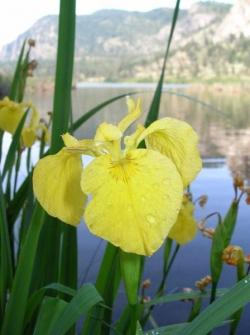
Week #2
Jumping the Garden Fence
As I mentioned last week, one of the most common questions asked of me is what makes a plant a weed. Probably the second most frequently asked question is, “But it’s so beautiful….is it really an invasive plant?” Many landowners, avid gardeners in particular, are hopeful that I will tell them that it is okay to plant a certain species. Everyone loves beautiful plants. Flowers and shrubs adorn our gardens, homes, parks and public spaces. With the ever-increasing popularity of gardening, the importation of plants to Canada from areas all around the globe is on the rise. Ornamental plants escaping from the garden can have a devastating impact on our natural habitats and the plants and animals they support. Not all ornamental plants pose this threat, but certain ones are capable of getting established and taking over hundreds and sometimes thousands of acres. Most of these invasive plants came from Europe or Asia and are lacking their natural insect enemies, which gives them a competitive advantage over our native plants. Making informed choices for your garden or landscape project can help safeguard our region’s environment and economy for future generations from the impacts of invasive plants.
Many plant traits that are desirable to gardeners—such as easy germination and establishment, tolerance to drought and frost, rapid growth and abundant seed production—enable a plant species to become invasive. When purchasing plants from your local nursery or garden centre, find out if the plant you desire is a “fast spreader” or a “vigorous self-seeder” in your planting zone. If so, these are warning signs that the species may be invasive. In most cases, there are alternative, non-invasive plants that are equally attractive.
Until recently, there has been no coordinated approach to reduce the distribution of invasive plants through retail or landscaping in BC. However, during the past two years, the Invasive Plant Council of BC has been working in partnership with the BC Landscape and Nursery Association, master gardeners, landscapers, retailers and others across BC to work together to curb the introduction and spread of horticulture invasive plants. This group has developed a list of the top 13 “unwanted” horticulture plants for the southern region of BC. I will discuss many of these species in upcoming articles. This week I will focus on one that happens to be my least favorite escaped ornamental, yellow flag iris (Iris pseudacorus). I have written about this plant in previous years, but it bears repeating, as this invader continues to be transplanted and sold at nurseries, garden centres and farmer’s markets.
Yellow flag iris is a strikingly beautiful plant that has covertly moved beyond the boundaries of our backyard plantings into our natural water habitats in recent decades. While it is a relatively new invader to BC’s Southern Interior, in recent years yellow flag iris has rapidly spread throughout the Okanagan valley, lower Similkameen valley, Christina Lake and other isolated sites in the West Kootenays. It is listed as a noxious or invasive weed in six US States including Washington State.
Yellow flag iris prefers saturated soils, invading wetlands, creeks and shallow lake margins. It fills a similar niche to that of cattails and often grows alongside this native plant, though usually in less deep water. Yellow flag iris is a European perennial plant that is most readily identified by its bright yellow flowers, which are evident right now. Its flat upright leaves are sword-shaped and surround the flower stalks. When mature, its fruit capsules resemble hanging bunches of short green bananas. Seeds are caught in the wind and blown into the water, where they are then carried further downstream. Broken pieces of the stout rhizome are also transported downstream where they take root and establish new plants.
Yellow flag iris is a fast-growing and fast-spreading invasive plant that can outcompete other riparian (water loving) plants, forming almost impenetrable thickets. In doing so, it alters wildlife habitat, impacting many riparian dependent species, particularly amphibians and birds. This yellow iris may also clog waterways and interrupt the natural water filtration services provided by native riparian or aquatic plants. In this manner it joins other wetland invaders such purple loosestrife (Lythrum salicaria).
While some plant enthusiasts may argue that sterile hybrids of this particular iris species are a good alternative, several nursery owners or managers will disagree. It is not unknown for supposedly sterile plants to produce a certain amount of viable seed. Also, one must remember that this iris additionally spreads via rhizomes so even complete elimination of seed production will not prevent its spread.
Plant enthusiasts can unintentionally spread potentially harmful plants when they share specimens among friends, neighbors and gardening clubs, or dispose of aquatic plants by releasing them into a natural waterway. Invasive plants are also spread when gardeners moving to warmer climates take plants with them that would otherwise have been controlled in colder climates (i.e. killed during winter). Instead, these plants thrive and become invasive in their new warmer habitat.
Not transplanting or purchasing this aggressive import can help to reduce spread. Consider planting other wetland plants such as native cattail (Typha latifolia) or non-invasive iris species such as Iris Louisiana mix or True Blue. If a yellow hue is preferred, then plant Marsh Marigold or yellow water lily. There are all kinds of other flora to decorate backyard ponds with that provide attractive cover and colour. You can also help to prevent the further spread of yellow flag iris by reporting new infestations to your regional invasive plant program coordinator.
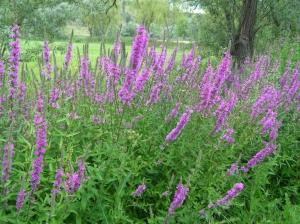
Week #1
What Makes a Plant a Weed?
Hi all! I am officially back as the Invasive Plant Program Coordinator for the Okanagan-Similkameen Regional District. Despite a slow start to spring, everything is now growing with great gusto, including of course, the weeds. To kick-start the ‘Weed of the Week’ series, I thought I’d talk about what actually makes a plant a weed, as this is one of the most common questions asked of me.
The most basic definition of a weed is a plant growing where it is not wanted. However, this leaves a lot open to interpretation. For example, here in Canada, dandelions are considered weeds, and some people go to a great deal of trouble and expense to get rid of them. In Britain, dandelions are considered a delicacy, and they are carefully cultivated for salad greens and other food uses. Purple loosestrife, an invasive plant that poses a serious threat to wetlands in Canada, was formerly grown as an ornamental plant. Even canola, a widely cultivated oilseed crop, could be considered a weed if it crops up unexpectedly in a wheat field.
The scientific definition of weeds is much more rigorous, and depends on how aggressive the plant is, how hardy it is, and how quickly it tends to spread. By this definition, dandelions and purple loosestrife would be considered weeds, at least in Canada. Crop plants growing where they are not supposed to, such as in a field of some other crop, are called “volunteers”.
The term noxious weed is one that I rarely make reference to, predominantly because most people do not fully understand the word ‘noxious’ which is in fact a legal definition under the BC Weed Control Act. The Regulations associated with this Act and the listing of noxious weeds is presently being reviewed by the Ministry of Agriculture and Lands and I would not be surprised if we see the removal of this designation in the near future. My preference would be to refer to these plants as obnoxious, more than noxious, which probably fits most readers’ definitions also!
Anyone who has heard me give a presentation in recent years has heard me refer to weeds more commonly as invasive plants. This global shift in name change is, in part, an acknowledgement that these typically non-native plants pose a threat beyond our backyards and agricultural lands into natural ecosystems. Invasive plant is a name for a species that out-competes and displaces other plants. Invasive plants tend to appear on disturbed ground, and the most aggressive species can actually invade existing natural ecosystems to the detriment of our native plants and animals. Invasive plants are generally undesirable because they are difficult to control, can escape from cultivation, and can dominate large expanses of land. In short, invasive plant infestations can be extremely expensive to control and their introduction or spread threatens the environment, the economy and society, including human health.
A small number of invasive plants are native to North America, meaning they occurred on the continent before settlement by Europeans but became aggressive after the landscape was altered. However, most invasive plants arrived from other continents and are often referred to as "exotic," "alien" introduced," or "non-native" invasives.
A recent document published by the Canadian Food Inspection Agency highlights an interesting history of invasive plant arrival to Canada. This report states that there are an estimated 486 invasive plant species in Canada. Many invasive plants came to Canada during the period from 1800 to 1900, with increased, trade, immigration, and colonization. It is estimated that 0.58 new invasive alien plant species have become established in Canada every year in the past century.
About 58% of invasive plants appear to have arrived through intentional introductions from other countries as agricultural crops, landscape plants, ornamentals and plants for medicinal and research purposes. More than 80% of invasive plants originated from primarily from Europe, western Russia and the Mediterranean, with the second largest group (15%) coming from China and Japan. Future introductions of potentially invasive plants into Canada are likely to come from eastern Asia, southern South America and the United States, because of their climatic similarities to out country and current Canadian trade patterns.
In the coming weeks, my articles will focus on the wide variety of escaped ornamental plants that occur in the Okanagan-Similkameen region. Please let me know if there is a particular invader or topic that you would like highlighted.


